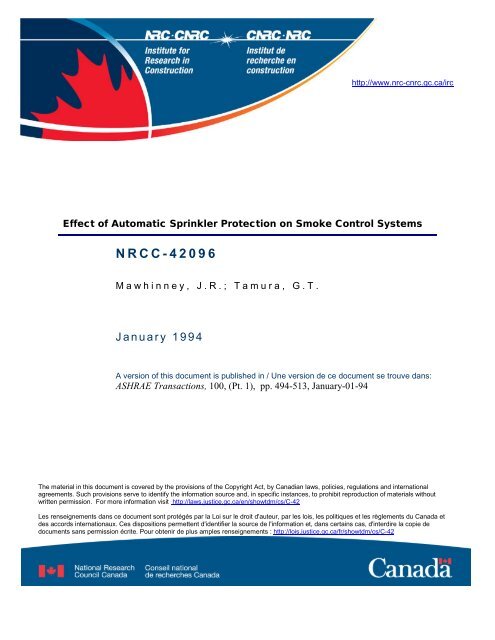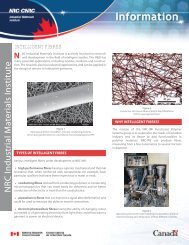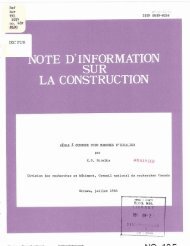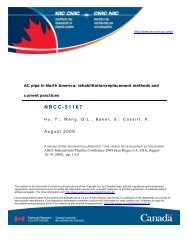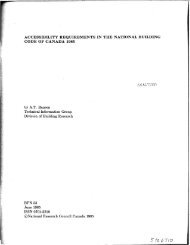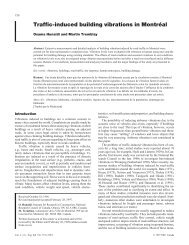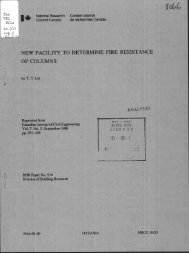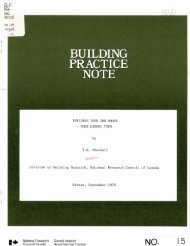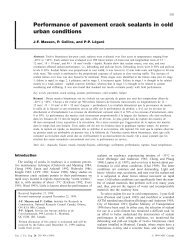Effect of Automatic Sprinkler Protection on Smoke Control Systems
Effect of Automatic Sprinkler Protection on Smoke Control Systems
Effect of Automatic Sprinkler Protection on Smoke Control Systems
You also want an ePaper? Increase the reach of your titles
YUMPU automatically turns print PDFs into web optimized ePapers that Google loves.
smoke from the building. Studies such as these c<strong>on</strong>tributeto a quantitative understanding <str<strong>on</strong>g>of</str<strong>on</strong>g> the interacti<strong>on</strong> betweensprinklers and the buoyant layer. They are theoretical,however, and most have not yet been validated by full-scaletesting.In the absence <str<strong>on</strong>g>of</str<strong>on</strong>g> full-scale test data <strong>on</strong> the maximumfire size to be expected in a sprinklered <str<strong>on</strong>g>of</str<strong>on</strong>g>fice building,Morgan and Hansell (1985) c<strong>on</strong>ducted a review <str<strong>on</strong>g>of</str<strong>on</strong>g> Britishfire loss statisticsc Their objective was to identify' a "designfire" size for use in designing smoke ventilati<strong>on</strong> systems foratria in sprinklered and unsprinklered buildings. Theirreview indicated that the maximum heat release rates andareas <str<strong>on</strong>g>of</str<strong>on</strong>g> fire involvement in sprinklered buildings weremuch lower than in unsprinklered buildings. Fires insprinklered buildings were estimated to have attained heatrelease rates between 285 and 2,850 Btu/s (300 and 3,000kW) before being extinguished by the sprinklers, with theprobability <str<strong>on</strong>g>of</str<strong>on</strong>g> occurrence <str<strong>on</strong>g>of</str<strong>on</strong>g> smaller fires much higher thanfor larger fires. This study supported the British designpractice for smoke c<strong>on</strong>trpl systems <str<strong>on</strong>g>of</str<strong>on</strong>g> assuming a 5-MWdesign fire under sprinklered c<strong>on</strong>diti<strong>on</strong>s, with an area <str<strong>on</strong>g>of</str<strong>on</strong>g> 10n:Jl. Morgan and Hansell's informati<strong>on</strong> is a useful startingpoint for examining the questi<strong>on</strong> regarding the likelihood <str<strong>on</strong>g>of</str<strong>on</strong>g>occurrence and size <str<strong>on</strong>g>of</str<strong>on</strong>g> shielded fires in sprinklered buildings.Gustafss<strong>on</strong> (1989), Heskestad (1974), Hinkley (1989),and Battrick (1986) report <strong>on</strong> the l<strong>on</strong>g-standing c<strong>on</strong>troversybetween sprinkler and ventilati<strong>on</strong> experts about whether ornot ventilati<strong>on</strong> <str<strong>on</strong>g>of</str<strong>on</strong>g> hot gases from a sprinklered buildingthrough ro<str<strong>on</strong>g>of</str<strong>on</strong>g> Vel)tS during a fire is beneficial to the c<strong>on</strong>trol<str<strong>on</strong>g>of</str<strong>on</strong>g> the fire. <str<strong>on</strong>g>Sprinkler</str<strong>on</strong>g> experts argue that automatic smokevents detract from proper performance <str<strong>on</strong>g>of</str<strong>on</strong>g> the sprinklersystem. <strong>Smoke</strong> ventilati<strong>on</strong> specialists, in tum, argue thatreduced smoke logging <str<strong>on</strong>g>of</str<strong>on</strong>g> the building improves interiorfirefighting and reduces smoke damage. Although somefull-scale studies have been d<strong>on</strong>e (Gustafss<strong>on</strong> 1989), theyare usually based <strong>on</strong> either a <strong>on</strong>e-story warehouse buildn1gor a shopping mall, with ro<str<strong>on</strong>g>of</str<strong>on</strong>g> vents, and are therefore notimmediately useful for analyzing the impact <str<strong>on</strong>g>of</str<strong>on</strong>g> sprinklers <strong>on</strong>an operating z<strong>on</strong>ed smoke c<strong>on</strong>trol system in a high-risebuilding.Two notable excepti<strong>on</strong>s to the shortage <str<strong>on</strong>g>of</str<strong>on</strong>g> full-scaleexperimental work involving sprinklers and smoke c<strong>on</strong>trolmeasures are studies c<strong>on</strong>ducted by the Seattle Fire Depart- .ment in an <str<strong>on</strong>g>of</str<strong>on</strong>g>fice building (Seattle FD 1984) and by Kloteat a hotel in Washingt<strong>on</strong>, DC (Klote 1990). The Seattlework looked at fire pressures generated by sprinklered andunsprinklered fires; carb<strong>on</strong> m<strong>on</strong>oxide generated by sprinklered,shielded fires; and the performance <str<strong>on</strong>g>of</str<strong>on</strong>g> three smokec<strong>on</strong>trol approaches: stairwell· pressurizati<strong>on</strong>, elevator shaftpressurizati<strong>on</strong>, and z<strong>on</strong>ed smoke c<strong>on</strong>trol. The Seattle studyc<strong>on</strong>cluded that sprinklers were indeed effective in reducingfire pressures and thereby improved the likelihood thatsmoke c<strong>on</strong>trol systems designed to current standards (forassumed n<strong>on</strong>sprinklered c<strong>on</strong>diti<strong>on</strong>s) would prevent smokespread. There was no suggesti<strong>on</strong> that design standards couldbe reduced for sprinklered fire c<strong>on</strong>diti<strong>on</strong>s. Problems <str<strong>on</strong>g>of</str<strong>on</strong>g> lossASH RAE Transacti<strong>on</strong>s: Research<str<strong>on</strong>g>of</str<strong>on</strong>g> stair pressurizati<strong>on</strong> <strong>on</strong> opening <str<strong>on</strong>g>of</str<strong>on</strong>g> doors, with subsequentc<strong>on</strong>taminati<strong>on</strong> <str<strong>on</strong>g>of</str<strong>on</strong>g> the stairshafts, were noted. The resultsprovide a useful starting point for further validating studies.Klote (1990) studied n<strong>on</strong>sprinklered fires with smokec<strong>on</strong>trol and sprinklered · filllS without smoke c<strong>on</strong>trol in aseries <str<strong>on</strong>g>of</str<strong>on</strong>g> full-scale tests in a h9tel in Washingt<strong>on</strong>, DC,which was destined to be demolished. He noted that firepressures were very low in the sprinklered fires and wouldnot likely pose a challenge for a smoke c<strong>on</strong>trol systemdesigned to meet current standards (Klote and Milke 1992;NFPA 1988). Klote (1990) noted that more tests would berequired, however, to determine how operati<strong>on</strong> <str<strong>on</strong>g>of</str<strong>on</strong>g> thesmoke c<strong>on</strong>trol system in the sprinklered fires would havechanged smoke spread bey<strong>on</strong>d the fire floor. He also notedthat, for sprinklered fires that are not rapidly extinguished,smoke producti<strong>on</strong> could be significant and smoke c<strong>on</strong>trolcould be useful.The ability <str<strong>on</strong>g>of</str<strong>on</strong>g> sprinkler systems to c<strong>on</strong>trol and extitiguishunshielded fires is well established (Richards<strong>on</strong> 1983;Walt<strong>on</strong> 1988; Madrzykowski and Vettori 1992). In resp<strong>on</strong>seto Klote's c<strong>on</strong>cerns about shielded fires, however, it wasdecided to pay particular attenti<strong>on</strong> to fires that could not beextinguished immediately by· the sprinklers and that wouldresult in sustained smoke producti<strong>on</strong> under cool c<strong>on</strong>diti<strong>on</strong>s.On the basis <str<strong>on</strong>g>of</str<strong>on</strong>g> Klote' s suggesti<strong>on</strong>s for further research, theTechnical Committee (TC 5.6) <strong>on</strong> Fire and <strong>Smoke</strong> C<strong>on</strong>trol<str<strong>on</strong>g>of</str<strong>on</strong>g> the American Society <str<strong>on</strong>g>of</str<strong>on</strong>g> Heating; Refrigerating and AirC<strong>on</strong>diti<strong>on</strong>ing Engineers, Inc. (ASHRAE), agreed to providefunds for research to investigate the effects <str<strong>on</strong>g>of</str<strong>on</strong>g> sprinklers <strong>on</strong>the performance <str<strong>on</strong>g>of</str<strong>on</strong>g> a z<strong>on</strong>ed smoke c<strong>on</strong>trol system. TheNati<strong>on</strong>al Fire Laboratory <str<strong>on</strong>g>of</str<strong>on</strong>g> the Institute for Research inC<strong>on</strong>structi<strong>on</strong> at the Nati<strong>on</strong>al ReSearch Council <str<strong>on</strong>g>of</str<strong>on</strong>g> Canadaalso fu~ded the project.EXPERIMENT DESCRIPTIONA series <str<strong>on</strong>g>of</str<strong>on</strong>g> experiments involving shielded, sprinkleredfires was c<strong>on</strong>ducted at. the Nati<strong>on</strong>al Fire Laboratory's fullscalefire test facility located near Ottawa, Canada. Thefacility c<strong>on</strong>sists <str<strong>on</strong>g>of</str<strong>on</strong>g> a very large Bum Hall, in which a <strong>on</strong>estoryfire test room· was c<strong>on</strong>structed, and a 10-storyexperimental tower (referred to as the Tower). Both theTower and the <strong>on</strong>e-story test room were used to carry outthe testing for this project.One-Story Test RoomA <strong>on</strong>e-story fire test room (Figure 1) was c<strong>on</strong>structedinside the Bum Hall, equipped with sprinklers and instrumentedwit!t pressure, temperature, and gas analysis equipment.A products-<str<strong>on</strong>g>of</str<strong>on</strong>g>-combusti<strong>on</strong> collector attached to thetest room allowed oxygen calorimetry to be used to measurethe heat release rates <str<strong>on</strong>g>of</str<strong>on</strong>g> sprinklered fires. The roommeasured 20ft by 20 ft by 12ft (6.1 m by 6.1 m by 3.6 m)with an a!tached corridor that was 20 ft l<strong>on</strong>g by 8 ft wideby 12ft high (6.1 m by 2.4 m by 3.6 m) <strong>on</strong> <strong>on</strong>e side. Thecorridor could be pressurized independently <str<strong>on</strong>g>of</str<strong>on</strong>g> the test room495
<str<strong>on</strong>g>Sprinkler</str<strong>on</strong>g>s20'Exhaustopening.,""""""\Jo·_lNorth~----30'
hI'J]48'i'12.8'Air Serv. Eev. Eev. Floor Area • Watersupp y!5 2"0 Shaft ShaftSupplyVestibule·suShaftI Air mJ"sm~~(~ .,;,-Exh. /Sh~ L~_jShaft:l*.!:.11-.1~ ~.-Crib, 4' X 4' X 3'Viewing1-->r,-: \ LArea00West COII:idor 1 5'"'Notes:* = pendent sprinklerFigure 2including data-processing areas, are listed. as "light hazard"in NFPA Standard 13. That is, "quantities and/or combustibility<str<strong>on</strong>g>of</str<strong>on</strong>g> c<strong>on</strong>tents are low and fires with relatively low rates<str<strong>on</strong>g>of</str<strong>on</strong>g> heat release are expected" (NFPA 1991). No values arestated in .NFPA Standard 13 to quantify what c<strong>on</strong>stitutes a"relatively low" heat release rate (HRR), ·which is notsurprising, given that it depends <strong>on</strong> the specific occupancyarld compartment c<strong>on</strong>diti<strong>on</strong>s. Various authors have treatedwood cribs as representative <str<strong>on</strong>g>of</str<strong>on</strong>g> light hazard fuel packages(Walt<strong>on</strong> 1988; Madrzykowski and .Vettori 1992). A woodcrib canilot completely simulate "real" burning c<strong>on</strong>diti<strong>on</strong>s,however, in that the fuel is c<strong>on</strong>centrated in a limited· arearather than· distributed over a large space. All <str<strong>on</strong>g>of</str<strong>on</strong>g> the fuelwithin the crib can bum at <strong>on</strong>ce, whereas fuel distributedQver a larger area will bum sequentially as fire spreadsfrom <strong>on</strong>e object to another .. For test purposes, it waspractical to use wood cribs that produced an HRR representative<str<strong>on</strong>g>of</str<strong>on</strong>g> a typical <str<strong>on</strong>g>of</str<strong>on</strong>g>fice workstati<strong>on</strong> in which a certain mass<str<strong>on</strong>g>of</str<strong>on</strong>g> fuel is c<strong>on</strong>centrated within a relatively small area.Madrzykowski and Vettori (1992) tested typical <str<strong>on</strong>g>of</str<strong>on</strong>g>ficeworkstati<strong>on</strong> fuel packages c<strong>on</strong>sisting <str<strong>on</strong>g>of</str<strong>on</strong>g> a desk, table,padded chairs, boxes <str<strong>on</strong>g>of</str<strong>on</strong>g> paper partially shielded under thedesk, etc., weighing a total <str<strong>on</strong>g>of</str<strong>on</strong>g> 639 Jb (290.5 kg). Averageheat release rates during unsuppressed burning <str<strong>on</strong>g>of</str<strong>on</strong>g> this fuelpackage were reported to be approximately 570 Btu/s (600kW), with several peaks as high as 1,235 Btu/s (1,300 kW)as various comp<strong>on</strong>ents <str<strong>on</strong>g>of</str<strong>on</strong>g> the package ignited sequentially.Madrzykowski and Vettori's workstati<strong>on</strong> HRR results canbe used as a benchmark for comparis<strong>on</strong> with the wood cribfires used in these tests.Wood cribs <str<strong>on</strong>g>of</str<strong>on</strong>g> two sizes were used in these experiments.·In the 10-story tower, cribs weighed approximately600 Jb (272 kg). The unsprinklered heat release rate fromPlan <str<strong>on</strong>g>of</str<strong>on</strong>g> the J().story tower, seventh floor.these cribs was measured at 1,150 Btu/s (1,200 kW). Theywere 66 lb (30 kg) heavier than the workstati<strong>on</strong>s describedin Madrzykowski and Vettori (1992); however, the exteriorrows <str<strong>on</strong>g>of</str<strong>on</strong>g> wood in the cribs, which were wetted by sprinklerspray, did not bum. The actual weight <str<strong>on</strong>g>of</str<strong>on</strong>g> fuel c<strong>on</strong>sumed byfire was typically 350 Jb (160 kg), or about 50% <str<strong>on</strong>g>of</str<strong>on</strong>g> theinitial crib weight (Mawhinney et al. 1992). These woodcribs compare reas<strong>on</strong>ably well to the light hazard fuelloadings representative <str<strong>on</strong>g>of</str<strong>on</strong>g> an <str<strong>on</strong>g>of</str<strong>on</strong>g>fice occupancy described inMadrzykowski and Vettori (1992).In the tests in the <strong>on</strong>e-story room, larger wood cribswere used, typically weighing 1,200 Jb (545 kg). Again, notall <str<strong>on</strong>g>of</str<strong>on</strong>g> the fuel could bum because <str<strong>on</strong>g>of</str<strong>on</strong>g> wetting <str<strong>on</strong>g>of</str<strong>on</strong>g> the wood <strong>on</strong>the outer edges <str<strong>on</strong>g>of</str<strong>on</strong>g> the crib. Unsuppressed, and with themaximum ventilati<strong>on</strong> that could be provided in the <strong>on</strong>e-storyroom, a peak heat release rate <str<strong>on</strong>g>of</str<strong>on</strong>g> 2,850 Btu/s (3,000 kW)was measured for these cribs. Most <str<strong>on</strong>g>of</str<strong>on</strong>g> the tests werec<strong>on</strong>ducted at Jess than full ventilati<strong>on</strong> c<strong>on</strong>diti<strong>on</strong>s, however,which limited the heat release rate <str<strong>on</strong>g>of</str<strong>on</strong>g> an unsuppressed fireto 1,900 Btu/s (2,000 kW). These cribs did not represent alight hazard fuel loading, but, as stated earlier; the P.rimaryobjective <str<strong>on</strong>g>of</str<strong>on</strong>g> the testS in the <strong>on</strong>e-story room was to evaluatethe nature <str<strong>on</strong>g>of</str<strong>on</strong>g> the interacti<strong>on</strong> between sprinklers and the fire.This co.uld be dqne by creating a fire that could be sus·tained at relatively steady-state c<strong>on</strong>diti<strong>on</strong>s for a l<strong>on</strong>g time,while ventilati<strong>on</strong> and sprinkler density were varied.Wood. cribs were c<strong>on</strong>structed using 3.5-in. by 3.5-in.(90-mm by 90-mm) dry white pine sticks, spaced 3.5 in.(90 mm) apart and piled 10 rows (36 in. [0.91 m]) high. Inthe <strong>on</strong>e-story room, sticks were 70 in. (1.78 m) .l<strong>on</strong>g; in thetower, 48 in. (1.22 m) l<strong>on</strong>g. The total mass <str<strong>on</strong>g>of</str<strong>on</strong>g> wood in thecribs in the <strong>on</strong>e-story room was typically 1,200 lb (545 kg);those in the Tower were <strong>on</strong>·~verage 700 Ib (320 kg).ASH RAE Transacti<strong>on</strong>s: Research497
In ord
1An uncertainty analysis, applied to the measurements andequati<strong>on</strong>s used to calculate the heat release rate from oxygenc<strong>on</strong>sumpti<strong>on</strong> measurements, indicated that there is an uncertainty<str<strong>on</strong>g>of</str<strong>on</strong>g> 12% in the computed heat release rates. The presence' <str<strong>on</strong>g>of</str<strong>on</strong>g>significant amounts <str<strong>on</strong>g>of</str<strong>on</strong>g> water in the products <str<strong>on</strong>g>of</str<strong>on</strong>g> combusti<strong>on</strong>increased the uncertainty in the oxygen c<strong>on</strong>sumpti<strong>on</strong> calculati<strong>on</strong>s.The mass loss rate <str<strong>on</strong>g>of</str<strong>on</strong>g> the burning cribs was measured with anaccuracy <str<strong>on</strong>g>of</str<strong>on</strong>g> ±2%, although the combined effects <str<strong>on</strong>g>of</str<strong>on</strong>g> mass loss dueto burning and evaporati<strong>on</strong> and mass gain due to the c<strong>on</strong>stantspray <str<strong>on</strong>g>of</str<strong>on</strong>g> sprinkler water <strong>on</strong>to the crib complicated interpretati<strong>on</strong><str<strong>on</strong>g>of</str<strong>on</strong>g> the mass loss measurements. The overall uncertainty in the heatrelease rates was estimated to approach 1 S%.ASHRAE Transacti<strong>on</strong>s: Research]"'~0:<str<strong>on</strong>g>Sprinkler</str<strong>on</strong>g> spray density, Lprnlm 20 2 3 4 5 6 7 8' ..'22002000 ~ UnsprinkleredOne-storey Test Room Results 20001800' 1200 lb (545 kg) wood cribs' - 18001600 f-' ' ,,#"Envelope- 16001400'50 % ltducti<strong>on</strong>I ' ' 'Unshielded -400I ·=- {""\""'L 400200 f- # 'Figure 3""1400600,.2000 ' • ' 00.00 0.05 0.10 0.15 0.20<str<strong>on</strong>g>Sprinkler</str<strong>on</strong>g> spray densily, USgpmtft'• Nore: HRR at a given density depends <strong>on</strong> staa:e <str<strong>on</strong>g>of</str<strong>on</strong>g> fire developmentprior to applicati<strong>on</strong> <str<strong>on</strong>g>of</str<strong>on</strong>g> water spray, See discussi<strong>on</strong> in tcxL01200'1100 f-',1000tests between the computed heat release rate based <strong>on</strong>oxygen calorimetry and that determined using the measurements<str<strong>on</strong>g>of</str<strong>on</strong>g> mass loss, the same factor was used to determinethe heat release rate <str<strong>on</strong>g>of</str<strong>on</strong>g> the wood cribs in the Tower tests. 1Tests were c<strong>on</strong>ducted with no sprinklers, with sprinklersand shielding, and with sprinklers and no shielding. Inthe oO:e test without sprinklers, which was c<strong>on</strong>ducted in the<strong>on</strong>e-story room, the fire in the I ,200-lb (545-kg) cribattained an HRR <str<strong>on</strong>g>of</str<strong>on</strong>g> more than 1,900 Btu/s (2,000 kW)under limited ventilati<strong>on</strong> c<strong>on</strong>diti<strong>on</strong>s <str<strong>on</strong>g>of</str<strong>on</strong>g> I ,000 cfm (0.42m 3 /s). By increasing the ventilati<strong>on</strong> rate to 1,500 cfm (0.63m3/s), the HRR increased to 3,000 kW. No unsprinkleredcase was tested in the Tower, but it is estimated fromburning rates observed during periods when the sp_rinklerspray was turned <str<strong>on</strong>g>of</str<strong>on</strong>g>f during the course <str<strong>on</strong>g>of</str<strong>on</strong>g> the test that the700-lb (318-kg) cribs would have had an HRR <str<strong>on</strong>g>of</str<strong>on</strong>g> 1,150Btu/s (1,213 kW) under unsprinklered c<strong>on</strong>diti<strong>on</strong>s.Several tests were c<strong>on</strong>ducted using fast-resp<strong>on</strong>sesprinklers (listed for <str<strong>on</strong>g>of</str<strong>on</strong>g>fice occupancies), which operated 30to 50 sec<strong>on</strong>ds faster than standard sprinklers. Normally,faster resp<strong>on</strong>se would he a significant advantage for firesuppressi<strong>on</strong> because the HRR <str<strong>on</strong>g>of</str<strong>on</strong>g> the fire is smaller earlierin the fire growth, hence the fire is easier to extinguish.The advantage was so<strong>on</strong> dissipated, however, for shieldedfires. After an initial slowing <str<strong>on</strong>g>of</str<strong>on</strong>g> the burning rate, withinseveral minutes the fire within the shielded area regrew tothe same size it achieved with standard sprinklers.Ten tests were c<strong>on</strong>ducted with shielded
ecause each data point represents an early stage in thefires, such that the preceding histories <str<strong>on</strong>g>of</str<strong>on</strong>g> the crib fires weremore comparable than in the tests in the <strong>on</strong>e-story room.Again, the dashed diag<strong>on</strong>al line linking the unsprinklered tothe sprinklered-shielded points shows a str<strong>on</strong>g relati<strong>on</strong>shipbetween the spray density and the HRR <str<strong>on</strong>g>of</str<strong>on</strong>g>a fire,From the dashed line in Figure 3, it can be c<strong>on</strong>servativelyestimated that the HRR <str<strong>on</strong>g>of</str<strong>on</strong>g> the fires would be reducedto less than SO% <str<strong>on</strong>g>of</str<strong>on</strong>g> the n<strong>on</strong>sprinklered rate at an approximatedensity <str<strong>on</strong>g>of</str<strong>on</strong>g> 0.11 gprn!ft2 (4.5 Llmin·m 2 ). That HRR(for the 1,200-lb crib) was about 97S Btu/s (1,02S kW).For ihe 700-lb (318-kg) wood cribs in the Tower tests(Figure 4), the same SO% reducti<strong>on</strong> in HRR (to S70 Btu/s[600 kW]) occurred at a density <str<strong>on</strong>g>of</str<strong>on</strong>g> 0.13 gprn!ft 2 (S.3Llmin·m 2 ). It is noteworthy that the reduced, sustained heatrelease rates at comparable densities were in proporti<strong>on</strong> tothe mass <str<strong>on</strong>g>of</str<strong>on</strong>g> fuel within the shielded area.Two tests, <strong>on</strong>e in the <strong>on</strong>e-story room and the other inthe Tower, were c<strong>on</strong>ducted with the shielding removed sothat the sprinkler spray could extinguish the fires. In bothcases, the fires were extinguished in less than 12 minutes.The HRR values shown in Figures 3 and 4 for the unshieldedfires were peak values, measured just beforesprinklers activated, which then reduced to zero as the firewas extinguished.This leads to the questi<strong>on</strong> <str<strong>on</strong>g>of</str<strong>on</strong>g> what level <str<strong>on</strong>g>of</str<strong>on</strong>g> fire c<strong>on</strong>trolis expected from a typical sprinkler system designed to meetNFPA Standard 13 (NFPA 1991). That standard distinguishesbetween "fire c<strong>on</strong>trol" and "fire suppressi<strong>on</strong>" andrecognizes that the sprinkler system is deemed to haveachieved .fire c<strong>on</strong>trol if it limits the size <str<strong>on</strong>g>of</str<strong>on</strong>g> the fire, decreasesthe HRR, and c<strong>on</strong>trols ceiling temperatures. The limits<strong>on</strong> the size <str<strong>on</strong>g>of</str<strong>on</strong>g> the fire (area) are not stated but clearly willbe some fracti<strong>on</strong> <str<strong>on</strong>g>of</str<strong>on</strong>g> the "design area," which is the areaprotected by the maximum number <str<strong>on</strong>g>of</str<strong>on</strong>g> sprinklers permitted(by the NFPA Standard 13 design criteria) to open. Thec<strong>on</strong>trol over ceiling temperatures also relates to the designarea: combusti<strong>on</strong> gases must be cooled within its boundaryso as not to activate sprinklers outside the design area. Theintended degree <str<strong>on</strong>g>of</str<strong>on</strong>g> c<strong>on</strong>trol over the heat release rate canthen be inferred: the HRR must be small enough that gastemperatures higher than the sprinkler temperature rating d<strong>on</strong>ot spread outside the design area.These experiments dem<strong>on</strong>strated that sprinklers substantiallyreduced the heat release rates <str<strong>on</strong>g>of</str<strong>on</strong>g> the wood crib fires,even though they were operating at lower spray densitiesthan would be normal for such fuel loads. They alsodem<strong>on</strong>strated that the magnitude <str<strong>on</strong>g>of</str<strong>on</strong>g> the heat release ratedepends <strong>on</strong> the amount <str<strong>on</strong>g>of</str<strong>on</strong>g> fuel present within the shieldedarea and that the fuel within that area will c<strong>on</strong>tinue burninguntil it is mostly c<strong>on</strong>sumed. Knowledge <str<strong>on</strong>g>of</str<strong>on</strong>g> the maximumarea <str<strong>on</strong>g>of</str<strong>on</strong>g> shielding possible in a sprinklered building (excludinga gross error in the system design) and the weight andtype <str<strong>on</strong>g>of</str<strong>on</strong>g> fuel likely to be held within the shielded area couldbe used to estimate the maximum beat release in a sprinklered,shielded fire.It was menti<strong>on</strong>ed earlier that the statistical review d<strong>on</strong>e500by Morgan and Hansell (198S) c<strong>on</strong>cluded that fires in asprinklered <str<strong>on</strong>g>of</str<strong>on</strong>g>fice building were likely to be between 28Sand 2,8SO Btu/s (300 and 3,000 kW), with a higher probability<str<strong>on</strong>g>of</str<strong>on</strong>g> occurrence <str<strong>on</strong>g>of</str<strong>on</strong>g> fires in the low end <str<strong>on</strong>g>of</str<strong>on</strong>g> the range.The results <str<strong>on</strong>g>of</str<strong>on</strong>g> this series <str<strong>on</strong>g>of</str<strong>on</strong>g> full-scale tests indicate thatshielded fires with heat release rates as high as 97S Btu/s(1,02S kW) are possible, depending <strong>on</strong> the amount <str<strong>on</strong>g>of</str<strong>on</strong>g> fueland the sprinkler density. The wood cribs in these tests,however, particularly in the <strong>on</strong>e-story room, represented asubstantial fuel mass arranged in an ideal burning formati<strong>on</strong>.Yet, <strong>on</strong>ly two sprinklers, operating at minimumdensities appropriate for their listing, kept the HRR below9SO Btu/s (1,000 kW). These measurements suggest thatshielded fires in sprinklered <str<strong>on</strong>g>of</str<strong>on</strong>g>fice buildings are likely tohave heat release rates below 9SO Btu/s (1,000 kW). Theresults also imply that for an occupancy in which shieldedfires are a possibility, design densities higher than theminimum recommended values for unshielded c<strong>on</strong>diti<strong>on</strong>swould be beneficial.<str<strong>on</strong>g>Effect</str<strong>on</strong>g>s <str<strong>on</strong>g>of</str<strong>on</strong>g> <str<strong>on</strong>g>Sprinkler</str<strong>on</strong>g>s <strong>on</strong> Heat Fluxto SurroundingsFigure S shows the intensity <str<strong>on</strong>g>of</str<strong>on</strong>g> radiant heat energy inthe <strong>on</strong>e-story test room, approximately 6.5 ft (2 m) fromthe wood crib, at mid-height <str<strong>on</strong>g>of</str<strong>on</strong>g> the room, measured atdifferent spray densities. In additi<strong>on</strong> to removing c<strong>on</strong>vectiveheat energy from the hot gases given <str<strong>on</strong>g>of</str<strong>on</strong>g>f by the fire,sprinklers reduce fire severity by absorbing radiant beatenergy in the fire compartment. In an unsprinklered fire,heat radiates from the visible flames and from the hot gaslayer that develops in the upper porti<strong>on</strong> <str<strong>on</strong>g>of</str<strong>on</strong>g> the room. Thisradiant heat reflects from surrounding surfaces back to the'¢:~1.41.21.0 -l! o.s -"' ,;=li: 0.6'a!u:I:0.40.20...,.,0.0 '0.00Figure 5<str<strong>on</strong>g>Sprinkler</str<strong>on</strong>g> spray density Lpm/ml2 3 4 s 6 7 8' ' ' ' '1614- 12.,~..,.1 Me10~8 ,;=li:6 'a!:!I ...y·' ' '4y ' y,Yy' ' '2''• 0o.os 0.10 O.lS 0.20<str<strong>on</strong>g>Sprinkler</str<strong>on</strong>g> spray density USgpmlft'Heat flux at mid-height <strong>on</strong> the south wall <str<strong>on</strong>g>of</str<strong>on</strong>g>the <strong>on</strong>e-story test room versus sprinkler spraydensity.ASH RAE Transacti<strong>on</strong>s: Research... ~
fire source and c<strong>on</strong>tributes to increasing the burning rate(Alpert attd Ward 1983), If the heat flux is high enough,combustible materials will ignite, or vulnerable surfaces,such as windows, could be broken. Alpert and Ward (1983)report that a.radiant flux <str<strong>on</strong>g>of</str<strong>on</strong>g> about 1.8 Btu/s·ft 2 (20 kW/ru 2 )will cause most combustible materials to ignite from anysmall pilot flame within a few minutes. Certain plastics willignite at lower flux levels. Furthermore, tempered glass islikely to break at a heat flux greater than 1.8 Btu/s·ft 2 (20kW/m2) (Kim and Lougheed 1990). It is advantageous,therefore, to reduce the intensity <str<strong>on</strong>g>of</str<strong>on</strong>g> radiant heat energy inthe fire compartment.Figure 5 dem<strong>on</strong>strates that the radiant heat at thelocati<strong>on</strong> <str<strong>on</strong>g>of</str<strong>on</strong>g> the heat flux meter was measured at about 1.1Btuift 2 (12.5 kW im 2 ) for the unsprinklered fire. Althoughnot high enough in itself to have readily ignited mostmaterials, it is the magnitude <str<strong>on</strong>g>of</str<strong>on</strong>g> the reducti<strong>on</strong> in heat fluxcaused by the sprinklers that is <str<strong>on</strong>g>of</str<strong>on</strong>g> interest. Even in ac<strong>on</strong>trolled situati<strong>on</strong>, sprinklers were effective in reducingradiant heat energy <strong>on</strong> the walls <str<strong>on</strong>g>of</str<strong>on</strong>g> the test .room by morethan 65% to less than 0.4 Btu/s·ft2 (4.8 kW/m2). The plotalso reveals that, with some variability in test results, therewas an abrupt improvement in the heat flux reducti<strong>on</strong> at athreshold spray density. The major benefit in heat fluxreducti<strong>on</strong> occurred at spray densities greater than 0.09gpmift 2 (3.7 L/min·m 2 ).<str<strong>on</strong>g>Effect</str<strong>on</strong>g>s <str<strong>on</strong>g>of</str<strong>on</strong>g> <str<strong>on</strong>g>Sprinkler</str<strong>on</strong>g>s <strong>on</strong> Room TemperaturesFigures 6 and 7 show a series <str<strong>on</strong>g>of</str<strong>on</strong>g> temperature pr<str<strong>on</strong>g>of</str<strong>on</strong>g>ilesin the <strong>on</strong>e-story test room at different rates <str<strong>on</strong>g>of</str<strong>on</strong>g> sprinklerspray applicati<strong>on</strong> and room ventilati<strong>on</strong>. Each pr<str<strong>on</strong>g>of</str<strong>on</strong>g>ile isplotted for a time during which burning c<strong>on</strong>diti<strong>on</strong>s andtemperatures in the room had stabilized after any changesin spray density or ventilati<strong>on</strong> rate: Figure 6 shows thetemperature pr<str<strong>on</strong>g>of</str<strong>on</strong>g>iles at different spray densities at a ventilati<strong>on</strong>rate <str<strong>on</strong>g>of</str<strong>on</strong>g> 1,000 cfm (0.42 rri'is). Figure 7 shows similartemperature pr<str<strong>on</strong>g>of</str<strong>on</strong>g>iles for a ventilati<strong>on</strong> rate <str<strong>on</strong>g>of</str<strong>on</strong>g> 1,500 cfm(0.63 m 3 /s). It is evident in Figure 7 that increasing theventilati<strong>on</strong> rate for the unsprinklered fire greatly increasedthe heat output and room temperature. With sprinklersoperating, however, the increased ventilati<strong>on</strong> caused <strong>on</strong>lyslight temperature increases.With the sprinklers shut <str<strong>on</strong>g>of</str<strong>on</strong>g>f, temperatures in the upperpart <str<strong>on</strong>g>of</str<strong>on</strong>g> the room reached approximately 1500•F (820°C) ata ventilati<strong>on</strong> rate <str<strong>on</strong>g>of</str<strong>on</strong>g> 1,000 cfm (0.42 m 3 /s) and 1700°F(926°C) for a ventilati<strong>on</strong> rate <str<strong>on</strong>g>of</str<strong>on</strong>g> 1,500 cfm (0.63 m 3 /s).These high temperatures existed throughout most <str<strong>on</strong>g>of</str<strong>on</strong>g> theheight <str<strong>on</strong>g>of</str<strong>on</strong>g> the room, and temperatures near the floor were·still more than 1200•F (650°C), Such temperatures represent"flashover" c<strong>on</strong>diti<strong>on</strong>s, which implies that everycombustible in a compartment would have become involvedin the fire. Fires that reach flashover have a high probability<str<strong>on</strong>g>of</str<strong>on</strong>g> spreading bey<strong>on</strong>d the compartment <str<strong>on</strong>g>of</str<strong>on</strong>g> origin andtherefore represent an augmented risk to the rest <str<strong>on</strong>g>of</str<strong>on</strong>g> thebuilding, according to a statistical review <str<strong>on</strong>g>of</str<strong>on</strong>g> fires in <str<strong>on</strong>g>of</str<strong>on</strong>g>ficeand residential high-rise buildings (Mailvaganam et a!.1992; Takeda and Yung 1991). It follows that there willalso be a high probability that smoke will spread bey<strong>on</strong>d thecompartment <str<strong>on</strong>g>of</str<strong>on</strong>g> origin if flashover c<strong>on</strong>diti<strong>on</strong>s are reached.What is striking about the temperature pr<str<strong>on</strong>g>of</str<strong>on</strong>g>iles inFigures 6 and 7 is the extent to which temperatures wereTemperature, •c0 100 200 300 400 500 600 700 800 900 1000123.5II2<str<strong>on</strong>g>Sprinkler</str<strong>on</strong>g> Density10I . 0.000 gpm/ft 2 3.0.::::92. 0.067 " E.: 8 2.5 .:3. 0.084 0 " 0..: 7c4. 0.105> "2.06 " >"0.. s . 0.109 " 5.81.5...0.E 6 . 0.110 ".2!' 4-..c7. ·;:;:I: " 3 1.0 :I:2 Room Ventilati<strong>on</strong> Rate- 1000 cfm0.5I0.200 "..0 0.0200 400 600 800 1000 1200 1400 1600 1800Temperature, •FFigure 6Temperature pr<str<strong>on</strong>g>of</str<strong>on</strong>g>iles at north thermocouple tree in the <strong>on</strong>e-story test room for different spray applicati<strong>on</strong> rates,for ventilati<strong>on</strong> rate <str<strong>on</strong>g>of</str<strong>on</strong>g> 1,000 cfm (0.42 m 3 Is).ASHRAE Transacti<strong>on</strong>s: Research 501
i.·t~', ~··~-:t··.a:Temperature, oc0 100 200 300 400 500 600 700 800 900 1000123.5II 3<str<strong>on</strong>g>Sprinkler</str<strong>on</strong>g> Density10I. 0.000 gpmift 2 3.0.::: 92 . 0.084 "E.: 8 2.50 3. 0.105 "~0 0
stages <str<strong>on</strong>g>of</str<strong>on</strong>g> a ftre, some pressure difference is created by theexpansi<strong>on</strong> <str<strong>on</strong>g>of</str<strong>on</strong>g> the air <strong>on</strong> the fire floor as it is heated. Forsustained, shielded fires, such as those used in theseexperiments, .however, the net temperature differencebetween the fire floor and the other 'z<strong>on</strong>es was the primarysource <str<strong>on</strong>g>of</str<strong>on</strong>g> fire-induced pressure. The effect <str<strong>on</strong>g>of</str<strong>on</strong>g> the sprinklerspray was to greatly reduce the temperature <strong>on</strong> the firefloor, with a corresp<strong>on</strong>ding reducti<strong>on</strong> in the buoyancypressure differences between the fire floor Md adjacentspaces.Pressures were measured at four elevati<strong>on</strong>s in both the<strong>on</strong>e-story test room and the seventh floor <str<strong>on</strong>g>of</str<strong>on</strong>g> the Tower,ranging from close to the floor to close to the ceiling. Allpressure. measurements were referenced to the adjacentn<strong>on</strong>fire space, such as the stairshaft in the Tower tests orthe Bum Hall for the tests in the <strong>on</strong>e-story room. Thereference pressure is shown as a vertical line at AP = 0 inFigures 8 and 10 and as a horiz<strong>on</strong>tal line in Figure 9; Whenthe fire ·compartment was not purposely depressurized bybeing mechanically exhausted, the initial pressure in the firecompartment was equal to the pressure in the adjacentn<strong>on</strong>fire spaces, so that the t.P was zero. As the fire beganto grow, hot gases accumulated near the ceiling, creating atemperature difference between the floor and ceiling. Thehot, buoyant ceiling layer generated a positive AP near theceiling, while at the same time, the pressure near the floorbecame increasingly negative relative to the adjacent spaceas the fire drew air toward itself. Curve A in Figure 8shows a typical pressure pr<str<strong>on</strong>g>of</str<strong>on</strong>g>ile for a n<strong>on</strong>sprinklered fireunder this c<strong>on</strong>diti<strong>on</strong>, with a positive and a negative pressurecomp<strong>on</strong>ent above and below the neutral plane, respectively.Curve B in the same figure shows the pressure pr<str<strong>on</strong>g>of</str<strong>on</strong>g>ile forthe (typical) case <str<strong>on</strong>g>of</str<strong>on</strong>g> a sprinklered fire: both the positive andnegative values <str<strong>on</strong>g>of</str<strong>on</strong>g> AP were at least SO% less than thepressures measured in a n<strong>on</strong>sprinklered fire due to cooling<str<strong>on</strong>g>of</str<strong>on</strong>g> the gases <strong>on</strong> the fire floor.The effects <str<strong>on</strong>g>of</str<strong>on</strong>g> sprinklers <strong>on</strong> the pressure c<strong>on</strong>diti<strong>on</strong>s inthe <strong>on</strong>e-story test room, with no mechanical exhaust inoperati<strong>on</strong>, are shown in Figure 9. It is clear that as spraydensity increased, the maximum positive AP and negativeAP diminished significantly. At a spray density <str<strong>on</strong>g>of</str<strong>on</strong>g> about0.11 gpm/ft2 ( 4.S Llminm2), the peak pressure differenceswere reduced by at least SO% from the n<strong>on</strong>sprinklered case.fligher spray densities resulted in even greater reducti<strong>on</strong>s in'buoyancy pressure. Note that it has been standard practicein smoke c<strong>on</strong>trol system design to allow a SO% reducti<strong>on</strong> inthe design pressure difference for a sprinklered building(Klote and Fothergill 1983; NFPA 1988). This practiceappears to be appropriate for the c<strong>on</strong>servative case <str<strong>on</strong>g>of</str<strong>on</strong>g>assumed minimal sprinkler density. For reas<strong>on</strong>s describedearlier, in most real ·fire scenarios, the initial sprinklerdischarge will exceed the minimum, and the averagetemperature <strong>on</strong> the fire floor will be less than the activati<strong>on</strong>temperature <str<strong>on</strong>g>of</str<strong>on</strong>g> the sprinklers: It should be expected, therefore,that buoyancy pressures will be much less than SO%<str<strong>on</strong>g>of</str<strong>on</strong>g> the unsprinklered values.ASH RAE Transacti<strong>on</strong>s: ResearchComparis<strong>on</strong> <str<strong>on</strong>g>of</str<strong>on</strong>g> Measured and Predicted PressuresAn equati<strong>on</strong> is provided in Klote and Milke (1992) toestimate the magnitude <str<strong>on</strong>g>of</str<strong>on</strong>g> the buoyancy pressure generatedby a fire:whereAP =K, =T. ===~t.P = K, • (I/T 0-liT!) • H (1)pressure differential across a barrier,· in. H 2 0(Pa);coefficient,7.64 (3460);ambient or reference air temperature, •R {K);absolute temperature <str<strong>on</strong>g>of</str<strong>on</strong>g> the fire, 0 R (K); andheight above ( +) or below (-) the neutral plane,ft (m).AP is the pressure difference across a boundary, withtemperature T 0<strong>on</strong> the n<strong>on</strong>fire side and temperature 1j <strong>on</strong>the fire side. H is the distance above or below the neutralplane, and K, is a coefficient that incorporates gas densityand unit c<strong>on</strong>versi<strong>on</strong>s. Equati<strong>on</strong> I calculates the maximumpressure difference (t.P) at distance H above or below theneutral plane, based <strong>on</strong> the difference in temperatures <strong>on</strong>the fire floor (Tj! and <strong>on</strong> the n<strong>on</strong>fire side <str<strong>on</strong>g>of</str<strong>on</strong>g> a barrier (T 0).To perform the calculati<strong>on</strong>, it is necessary to estimate theelevati<strong>on</strong> <str<strong>on</strong>g>of</str<strong>on</strong>g> the neutral plane (hence H) and to assume a"fire temperature" representative <str<strong>on</strong>g>of</str<strong>on</strong>g> the average c<strong>on</strong>diti<strong>on</strong>in the fire compartment. Uncertainties about the height <str<strong>on</strong>g>of</str<strong>on</strong>g>the neutral plane and in the calculati<strong>on</strong> <str<strong>on</strong>g>of</str<strong>on</strong>g> the fire temperature,both vertically and horiz<strong>on</strong>tally in the fire compartment,however, lead to difficulties in predicting fire-inducedbuoyancy pressure· differences. Klote (1990) found thatpredicted pressure differences across a barrier using theaverage measured temperature at the barrier were in goodagreement with measured pressure differences.For the r-ase <str<strong>on</strong>g>of</str<strong>on</strong>g> no mechanical exhaust <str<strong>on</strong>g>of</str<strong>on</strong>g> the fire floor,this positive AP ceiling shown in Figure 8 was measureddirectly by the instrumentati<strong>on</strong>. When the fire compartmentis mechanically exhausted, however, and adjacent spacesare purposely pressurized in order to create a z<strong>on</strong>ed smokec<strong>on</strong>trol c<strong>on</strong>diti<strong>on</strong>, the elevati<strong>on</strong> <str<strong>on</strong>g>of</str<strong>on</strong>g> the neutral plane <strong>on</strong> thefire floor becomes uncertain. In that case, the pressurepr<str<strong>on</strong>g>of</str<strong>on</strong>g>ile for the fire floor is drawn into the negative regi<strong>on</strong>,relative to the stairshaft, which is equivalent to raising theneutral plane above the ceiling <str<strong>on</strong>g>of</str<strong>on</strong>g> the fire floor, as shownin Figure 10. For the purposes <str<strong>on</strong>g>of</str<strong>on</strong>g> analyzing the experimentalmeasurements <str<strong>on</strong>g>of</str<strong>on</strong>g> the effects <str<strong>on</strong>g>of</str<strong>on</strong>g> sprinklers <strong>on</strong> buoyancypressures under c<strong>on</strong>diti<strong>on</strong>s <str<strong>on</strong>g>of</str<strong>on</strong>g> mechanical exhaust <str<strong>on</strong>g>of</str<strong>on</strong>g> the firefloor, it was useful to work with the net pressure differenceacross the wall <str<strong>on</strong>g>of</str<strong>on</strong>g> the stairshaft between the floor and theceiling <str<strong>on</strong>g>of</str<strong>on</strong>g> the fire floor, or I!..P•, as illustrated in Figure 10,instead <str<strong>on</strong>g>of</str<strong>on</strong>g> AP calculated from Equati<strong>on</strong> 1. From Figure 10it can be seen that AP• will equal AP when the value <str<strong>on</strong>g>of</str<strong>on</strong>g> Hin Equati<strong>on</strong> I equals the floor-to-ceiling height <str<strong>on</strong>g>of</str<strong>on</strong>g> the firefloor. Because the instrumentati<strong>on</strong> measured the AP at thefloor and ceiling levels relative to the adjacent n<strong>on</strong>fire503
I______'I·····------,+ ..,..y_;~---41'* -0.07 in. H20 (typ)MJceil-0.03 'A~_J_b==~~~~==~~~==~==~...0.~4 ...0.02 0 0.02 0.044Pf1oor - ..0.04Presswe, in. H2000.04<str<strong>on</strong>g>Sprinkler</str<strong>on</strong>g> spray density, Lpm/m 22 3 4 5 6 7I0,03 - Press~m:~ ner ceiling -0.02o .. 0.01"'...!:l: 0.00..:
horiz<strong>on</strong>tally throughout the fire compartment. AP" calculatedusing the average temperature <strong>on</strong> the fire side <str<strong>on</strong>g>of</str<strong>on</strong>g> the wall<str<strong>on</strong>g>of</str<strong>on</strong>g> the stairshaft in Equati<strong>on</strong> I gave good agreement withthe measured AP• at that locati<strong>on</strong>. Actual values <str<strong>on</strong>g>of</str<strong>on</strong>g> AP•measured between the fire floor and the stairshaft rangedfrom 0.008 to 0.016 in. H 2 0 (2 .to 4 Pa).To c<strong>on</strong>clude this discussi<strong>on</strong> <strong>on</strong> buoyancy pressures, thetests indicated that fire-induced buoyancy pressures decreasedas spray density increased and that a reducti<strong>on</strong> <str<strong>on</strong>g>of</str<strong>on</strong>g>50% <str<strong>on</strong>g>of</str<strong>on</strong>g> the design pressure difference for z<strong>on</strong>ed smokec<strong>on</strong>trol in sprinklered buildings is adequate but c<strong>on</strong>servative.Also, measured pressure differences compared wellwith predicted values when the average temperature acrossthe stairshaft wall was used. Note that predicting the averagetemperature at a specific locati<strong>on</strong> in the fire compartment,with wide variati<strong>on</strong> in the temperatures between <strong>on</strong>epart <str<strong>on</strong>g>of</str<strong>on</strong>g> ·the compartment and another, could be quitecomplex.Rapid Expansi<strong>on</strong> <str<strong>on</strong>g>of</str<strong>on</strong>g> Steam There was some interestin whether the introducti<strong>on</strong> <str<strong>on</strong>g>of</str<strong>on</strong>g> a water spray into the hotgases in the early stages <str<strong>on</strong>g>of</str<strong>on</strong>g> the fire would create a suddenpressure increase due to the rapid evaporati<strong>on</strong> <str<strong>on</strong>g>of</str<strong>on</strong>g> water.One <str<strong>on</strong>g>of</str<strong>on</strong>g> the fires in the <strong>on</strong>e-story room was allowed tobecome fully developed and the room very hot before thesprinklers were turned <strong>on</strong>. In that case, a rapid expansi<strong>on</strong><str<strong>on</strong>g>of</str<strong>on</strong>g> steam occurred, forcing smoke and steam out <str<strong>on</strong>g>of</str<strong>on</strong>g> the testroom at high velocity. Under normal c<strong>on</strong>diti<strong>on</strong>s <str<strong>on</strong>g>of</str<strong>on</strong>g> sprinkleroperati<strong>on</strong>, however, sprinklers are activated by the firstflow <str<strong>on</strong>g>of</str<strong>on</strong>g> hot gases rising from the fire. Ambient c<strong>on</strong>diti<strong>on</strong>sat that stage are not hot enough to cause instantaneousevaporati<strong>on</strong> <str<strong>on</strong>g>of</str<strong>on</strong>g> a large volume <str<strong>on</strong>g>of</str<strong>on</strong>g> water. In the tests in the<strong>on</strong>e-story room, the plots <str<strong>on</strong>g>of</str<strong>on</strong>g> AP versus time typicallyshowed that the rapid drop in temperature <str<strong>on</strong>g>of</str<strong>on</strong>g> the combusti<strong>on</strong>products, <strong>on</strong> activati<strong>on</strong> <str<strong>on</strong>g>of</str<strong>on</strong>g> the first sprinklers, resultedin an immediate pressure reducti<strong>on</strong> that more than compensatedfor the change in pressure caused by the rapidevaporati<strong>on</strong> <str<strong>on</strong>g>of</str<strong>on</strong>g> a relatively small amount <str<strong>on</strong>g>of</str<strong>on</strong>g> sprinkler spray.Pressure Required to Prevent <strong>Smoke</strong> Spread Acrossa Boundary Figure II shows the results <str<strong>on</strong>g>of</str<strong>on</strong>g> a series <str<strong>on</strong>g>of</str<strong>on</strong>g> testsc<strong>on</strong>ducted in the <strong>on</strong>e-story test room and attached corridor(see Figure I) to determine how much pressure wasrequired to prevent smoke ·from entering the corridor atdifferent temperatures in the fire room. The spray densitywas adjusted to a certain level, and c<strong>on</strong>diti<strong>on</strong>s in the fireroom were allowed to stabilize. A fan supplying air to thecorridor was adjusted to create a positive pressure betweenthe corridor and the fire room. The flow rate <str<strong>on</strong>g>of</str<strong>on</strong>g> the fan wasthen gradually reduced, and the pressure differences (atceiling level) between the two rooms at different flow rateswere recorded. When the value <str<strong>on</strong>g>of</str<strong>on</strong>g> AP between the twospaces reached zero, smoke could be observed leaking intothe corridor.These tests indicated that, when the fire-inducedbuoyancy pressure at the ceiling <str<strong>on</strong>g>of</str<strong>on</strong>g> the fire test room wasequal to or less than the prefire pressurizati<strong>on</strong> <str<strong>on</strong>g>of</str<strong>on</strong>g> thecorridor (AP d.sign), smoke would not flow into the protectedspace. These measurements c<strong>on</strong>firm that the movementTemperature, oc0 100 200 300 400 soo 6000.06 .-~...,-~-,.-.-..-~-..-.~...,--,...--.--,0.0.5~.5 0.04 -~ 0.03cI0.02O.otTest points I, 2, 3, 4 indicate pressure -14difference produced by corridorpressurizati<strong>on</strong> to prevent smoke entry,- 12<strong>on</strong>e~storey test room results.....10 c:-•0smoke entryP«ssure diffe)v~t~11!c• eil~- 4causod by fuc'\,2 . !o <strong>Smoke</strong> entry 2'•/omL-~~200L-~-... ~_. __ 600L-~-800~~~,ooo~_.~,~Figure 11Temperature. opPressure difference required to prevent smokeentry into corridor from the fire room, as afuncti<strong>on</strong> <str<strong>on</strong>g>of</str<strong>on</strong>g> fire room temperature.<str<strong>on</strong>g>of</str<strong>on</strong>g> smoke through leakage openings can be opposed by anequal pressure <strong>on</strong> the n<strong>on</strong>fire side <str<strong>on</strong>g>of</str<strong>on</strong>g> the barrier. Given thatthe maximum pressure difference between the floor andceiling (AP•) created by a sprinklered fire was about 0.05in. H 2 0 (12.5 Pa) in the <strong>on</strong>e-story test room and 0.016 in.H 2 0 (4 Pa) in the Tower, the accepted practice, which is todesign for AP 1<str<strong>on</strong>g>of</str<strong>on</strong>g> 0.05 in. H 2 0 (12.5 Pa), appears to bereas<strong>on</strong>able, i.e., adequate, but not excessive.<str<strong>on</strong>g>Effect</str<strong>on</strong>g>s <str<strong>on</strong>g>of</str<strong>on</strong>g> <str<strong>on</strong>g>Sprinkler</str<strong>on</strong>g>s <strong>on</strong> Gas C<strong>on</strong>centrati<strong>on</strong>sStudies c<strong>on</strong>ducted by Klote (1990), Walt<strong>on</strong> (1988), andWalt<strong>on</strong> and Budnick (1988) to measure the ability <str<strong>on</strong>g>of</str<strong>on</strong>g>sprinklers to suppress wood crib fires and fires in <str<strong>on</strong>g>of</str<strong>on</strong>g>ficefurnishings dem<strong>on</strong>strated that c<strong>on</strong>centrati<strong>on</strong>s <str<strong>on</strong>g>of</str<strong>on</strong>g> carb<strong>on</strong>dioxide (COz) and carb<strong>on</strong> m<strong>on</strong>oxide (CO) gases in theproducts <str<strong>on</strong>g>of</str<strong>on</strong>g> combusti<strong>on</strong> from a sprinklered fire were low.C0 2 may have reached 2% or 3% (ambient is 0.4% ), whileCO c<strong>on</strong>centrati<strong>on</strong>s were between 0.05% and 0.3% (50 and300 ppm) (ambient air c<strong>on</strong>tains no CO). The c<strong>on</strong>centrati<strong>on</strong>s<str<strong>on</strong>g>of</str<strong>on</strong>g> these gases first increased as the fire grew, then decreasedafter the sprinklers operated and the fire began tobe extinguished. The cited literature suggests that theamount <str<strong>on</strong>g>of</str<strong>on</strong>g> CO and C0 2 produced in an unsprinklered fireis much higher than in a suppressed fire because the fire islarger, bums l<strong>on</strong>ger, and c<strong>on</strong>sumes more <str<strong>on</strong>g>of</str<strong>on</strong>g> the availableoxygen.In c<strong>on</strong>trast, as illustrated by Figures 12a and 13a,shielded crib fires <strong>on</strong> the seventh floor (the fire floor) <str<strong>on</strong>g>of</str<strong>on</strong>g> theTower produced C0 2 c<strong>on</strong>centrati<strong>on</strong>s as high as 8% and 9%and CO c<strong>on</strong>centrati<strong>on</strong>s between 1.0% and !.5% (10,000 to15,000 ppm). These gas c<strong>on</strong>centrati<strong>on</strong>s were measured ata distance <str<strong>on</strong>g>of</str<strong>on</strong>g> 1.7 m above the floor, approximately 10. ft(3.05 m) from the wood crib, at the entrance to the west'ASHRAE Transacti<strong>on</strong>s: Research505
-----------I
ti<strong>on</strong>s <str<strong>on</strong>g>of</str<strong>on</strong>g> 10,000 ppm were recorded, representing lifethreateninglevels <strong>on</strong> the fire floor. A rule <str<strong>on</strong>g>of</str<strong>on</strong>g> thumbsuggested by Kaplan and Hartzell (1984) indicates that at anexposure to 10,000 ppm <str<strong>on</strong>g>of</str<strong>on</strong>g> CO for more than 3.5 minutes,most people will be at least incapacitated. Peacock et al.(1989) indicated that a c<strong>on</strong>centrati<strong>on</strong> <str<strong>on</strong>g>of</str<strong>on</strong>g> 15,000 ppm COwould present a severe life-safety hazard to any<strong>on</strong>e trapped<strong>on</strong> the fire floor.Figures 12b and 13b show the c<strong>on</strong>centrati<strong>on</strong>s <str<strong>on</strong>g>of</str<strong>on</strong>g> C0 2and CO <strong>on</strong> the ninth floor <str<strong>on</strong>g>of</str<strong>on</strong>g> the Tower. In Figure 12b, noz<strong>on</strong>ed smoke c<strong>on</strong>trol was in effect, whereas in Figure 13b,the z<strong>on</strong>ed smoke c<strong>on</strong>trol system was set up for a t:J' design<str<strong>on</strong>g>of</str<strong>on</strong>g> 0.05 in. H 2 0 (12.5 Pa). In the former case, with noz<strong>on</strong>ed smoke c<strong>on</strong>trol in effect, for most <str<strong>on</strong>g>of</str<strong>on</strong>g> the fire durati<strong>on</strong>smoke was c<strong>on</strong>fmed to the fire floor. When the seventhfloordoor to the stairshaft was opened, however, smoke..,;c0::: 2.0• ~~03.05 10 15 20 25 30 35t.la:nill<strong>on</strong> Open 72.5c 9th Aoor: No Z<strong>on</strong>e <strong>Smoke</strong> C<strong>on</strong>trol• uFast Rcspcmsc <str<strong>on</strong>g>Sprinkler</str<strong>on</strong>g>s· Shielded F"trec0 • ea:ivatc94• a&rignitiOI'l(t.,• 16 min)u 1.50u.,•• 1.0N0u40 45 50 55 60 65 70 75 80Opea edt.Test 1150.5t.coo.o0 5 10 15 20 25 30. 35 40 45 50 55 60 65 70 75 80nme, minFigure 13a C0 2 and CO c<strong>on</strong>centrati<strong>on</strong>s <strong>on</strong> the ninth floor <str<strong>on</strong>g>of</str<strong>on</strong>g> the 10-story tower for a shielded fire with no z<strong>on</strong>ed smokec<strong>on</strong>trol in effect.0.22Test 120.20 co,0.1891hfloor. Z<strong>on</strong>e Smol:o Coaaol AP-O.ll5lo.1120..0.16 Slmdani Spriddcrs -Shlddod F ..,; • - 1221 aflerlgoilioa (It" 7 IIIia)c0::: 0.14!I•li 0.12u• 0u00.10u.,•o.oe•N 0.0680.040.02 it.£DlU<strong>on</strong>OpeaZSC DD 7'ftme. miDFigure 13b C0 2 and CO c<strong>on</strong>centrati<strong>on</strong>s <strong>on</strong> the ninth floor <str<strong>on</strong>g>of</str<strong>on</strong>g> the 10-story tower for a shielded fire with smoke c<strong>on</strong>trol ineffect.ASHRAE Transacti<strong>on</strong>s: Research507
escaped from the fire floor, rose in the stairshaft, andleaked into the ninth floor. The C0 2 c<strong>on</strong>centrati<strong>on</strong> <strong>on</strong> theninth floor reached 2.65% and the CO c<strong>on</strong>centrati<strong>on</strong>reached 0.4%, or 4,000 ppm, over the next half-hour. Itwas observed that visual smoke c<strong>on</strong>taminati<strong>on</strong> <str<strong>on</strong>g>of</str<strong>on</strong>g> thestairshaft was severe, and it is inferred that the CO c<strong>on</strong>centrati<strong>on</strong>sin the stairshaft were necessarily higher than thosemeasured <strong>on</strong> the ninth floor. This plot illustrates the danger<str<strong>on</strong>g>of</str<strong>on</strong>g> smoke spread in a sprinklered building that has noadditi<strong>on</strong>al smoke c<strong>on</strong>trol features.With the z<strong>on</strong>ed smoke c<strong>on</strong>trol system operating, asmall amount <str<strong>on</strong>g>of</str<strong>on</strong>g> smoke leaked into the stairshaft after theseventh-floor door was opened. Visual smoke c<strong>on</strong>taminati<strong>on</strong>in the stairshaft was light, and the ninth-floormeasurements<str<strong>on</strong>g>of</str<strong>on</strong>g> C0 2 and CO showed that very little smoke was leakinginto that floor. When the eighth-floor (a pressurized z<strong>on</strong>e)door to the stairshaft was opened, however, the lightlyc<strong>on</strong>taminated shaft became pressurized and smoke wasforced into the ninth floor. The C0 2 c<strong>on</strong>centrati<strong>on</strong> rose toabout 0.2%, and the CO c<strong>on</strong>centrati<strong>on</strong> reached approxi~mately 0.01 %, or 100 ppm. Although some smoke didspread into the stairs under a z<strong>on</strong>ed smoke c<strong>on</strong>trol c<strong>on</strong>figurati<strong>on</strong>,the c<strong>on</strong>centrati<strong>on</strong>s <str<strong>on</strong>g>of</str<strong>on</strong>g> dangerous c<strong>on</strong>taminants wereminimal compared to the case with no z<strong>on</strong>ed smoke c<strong>on</strong>trol.On the fire floor in ·the Tower, the sprinklered,shielded fires c<strong>on</strong>sistently produced c<strong>on</strong>centrati<strong>on</strong>s <str<strong>on</strong>g>of</str<strong>on</strong>g>carb<strong>on</strong> m<strong>on</strong>oxide greater than 5,000 ppm, which, usingKaplan's rule, would lead to incapacitati<strong>on</strong> <str<strong>on</strong>g>of</str<strong>on</strong>g> most peoplein less than eight minutes. These dangerous c<strong>on</strong>centrati<strong>on</strong>s<str<strong>on</strong>g>of</str<strong>on</strong>g> C0 2 and CO appear to be .the result <str<strong>on</strong>g>of</str<strong>on</strong>g> inefficientcombusti<strong>on</strong> caused by burning under moist, cool, ventilati<strong>on</strong>-limitedc<strong>on</strong>diti<strong>on</strong>s. Volatized gases unable to bumcompletely inside the crib because <str<strong>on</strong>g>of</str<strong>on</strong>g> limited oxygennormally would have burned to completi<strong>on</strong> in the roomafter escaping the crib. Because the sprinkler sprayquenched this external combusti<strong>on</strong>, however, the combusti<strong>on</strong>process was never completed. It is also possible that achemical reacti<strong>on</strong> between carb<strong>on</strong> (in the wood) and watervapor (steam) occurred, producing CO and H 2 (Wiseman1983).A sustained, low-heat-output fire in a sprinklered <str<strong>on</strong>g>of</str<strong>on</strong>g>ficebuilding is c<strong>on</strong>sidered to be statistically plausible (Morganand Hansell 1985). Such fires occur when the fuel isshielded from the direct effects <str<strong>on</strong>g>of</str<strong>on</strong>g> the sprinkler spray sothat complete extinguislunent does not occur. Given that COc<strong>on</strong>centrati<strong>on</strong>s can at least in some cases be dangerous! yhigh, the smoke from a shielded, sustained fire representsa life-safety hazard in a building. Measures to preventsmoke from spreading from the fire floor into the rest <str<strong>on</strong>g>of</str<strong>on</strong>g>the building can be justified <strong>on</strong> this basis.<str<strong>on</strong>g>Effect</str<strong>on</strong>g>s <str<strong>on</strong>g>of</str<strong>on</strong>g> <str<strong>on</strong>g>Sprinkler</str<strong>on</strong>g>s <strong>on</strong> <strong>Smoke</strong> SpreadThe 10-story tower was set up to represent a buildingwith features <str<strong>on</strong>g>of</str<strong>on</strong>g> a z<strong>on</strong>ed smoke c<strong>on</strong>trol system in c<strong>on</strong>formancewith design procedures described in Klote and Milke(1992). The z<strong>on</strong>es c<strong>on</strong>sisted <str<strong>on</strong>g>of</str<strong>on</strong>g> the fire floor (floor F7), the508floors above and below the fire floor (floors F8 and F6,respectively), and the stairshaft, for four z<strong>on</strong>es in total. Theobjective <str<strong>on</strong>g>of</str<strong>on</strong>g> providing z<strong>on</strong>ed smoke c<strong>on</strong>trol was to ensurethat fire products (smoke) did not enter the stairshaft oreither <str<strong>on</strong>g>of</str<strong>on</strong>g> the floors above or below the fire. Three levels <str<strong>on</strong>g>of</str<strong>on</strong>g>initial pressurizati<strong>on</strong> were tested: tJ' "'"'" = 0.1 in. H 2 0 (25Pa), tJ' ""'"' = 0.05· in. H20 (12.5 Pa), and tJ' ""'"' = 0(i.e., no smoke c<strong>on</strong>trol). The first c<strong>on</strong>diti<strong>on</strong> represents thetJ' ""'"'recommended in NFPA 92A (1988) for a n<strong>on</strong>spriftkleredbuilding with an 8-ft (2.4-m) ceiling height; thesec<strong>on</strong>d is the recommended design point for a sprinkleredbuilding; and the last c<strong>on</strong>diti<strong>on</strong> corresp<strong>on</strong>ds to the case inwhich a sprinkler system is present, with no additi<strong>on</strong>alfeatures to prevent smoke spread.'Floors F8 and F6 were pressurized by the injecti<strong>on</strong> <str<strong>on</strong>g>of</str<strong>on</strong>g>air directly into each floor space. The combined air inflowrate to the two floors was either 5.1 or 4.8 air changes perhour (ACH), depending <strong>on</strong> whether the tJ' ""'"'was 0.1 in.H 2 0 or 0.05 in. H 2 0 (25 Pa or 12.5 Pa), respectively.Other floors in the 10-story tower were not pressurized.The fire floor was mechanically exhausted through anexhaust shaft at a rate <str<strong>on</strong>g>of</str<strong>on</strong>g> either 5.6 or 4.4 ACH, so that itwas at a negative pressure relative to all other floors in thebuilding. The stairshaft, however, was not directly pressurized.The tJ' across the stairshaft door <strong>on</strong> F7 was determinedby the exhaust rate for that floor plus any air leakageinto the stairshaft from other floors or by opening theexterior door at the bottom <str<strong>on</strong>g>of</str<strong>on</strong>g> the stairshaft. This method <str<strong>on</strong>g>of</str<strong>on</strong>g>achieving the "pressure sandwich" or z<strong>on</strong>ed smoke c<strong>on</strong>trolsystem c<strong>on</strong>formed with the intent <str<strong>on</strong>g>of</str<strong>on</strong>g> both Klote and Milke(1992) and NFPA 92A (1988).As already stated, three values for tJ' desi n• measuredacross the wall <str<strong>on</strong>g>of</str<strong>on</strong>g> the stairshaft <strong>on</strong> the seven!~ floor, weretested. For the tJ'desi n = 0 c<strong>on</strong>diti<strong>on</strong>, two tests wered<strong>on</strong>e, <strong>on</strong>e with an unst'lelded crib and the sec<strong>on</strong>d with ashielded crib. For each <str<strong>on</strong>g>of</str<strong>on</strong>g> the other c<strong>on</strong>diti<strong>on</strong>s <str<strong>on</strong>g>of</str<strong>on</strong>g> tJ'design•two shielded fires were studied, <strong>on</strong>e hotter than the other.The results <str<strong>on</strong>g>of</str<strong>on</strong>g> each c<strong>on</strong>diti<strong>on</strong> are reported in full in Part 2<str<strong>on</strong>g>of</str<strong>on</strong>g> the experiment report (Mawhinney et al. 1992). Highlights<str<strong>on</strong>g>of</str<strong>on</strong>g> the test results are summarized in the followingparagraphs.For the two cases <str<strong>on</strong>g>of</str<strong>on</strong>g> llPdesign = 0.1 or 0.05 in. H20(25 or 12.5 Pa), smoke from the shielded fire was c<strong>on</strong>finedto the fire floor as l<strong>on</strong>g as the door to the stairshaft waskept closed. Even at the lowest sprinkler spray rates, thebuoyancy pressures created by the fire were not highenough to overcome the initial tJ'design' However, inalmost all cases, as so<strong>on</strong> as the door to the seventh floor(F7) was fully opened, smoke escaped into the stairshaft.The <strong>on</strong>ly time that smoke did not enter the stairshaft afteropening the door to the fire floor was when the stairshafthad been pressurized by opening <strong>on</strong>e <str<strong>on</strong>g>of</str<strong>on</strong>g> the doors to a2 Tiiis latter c<strong>on</strong>diti<strong>on</strong> is accepted in some building code jurisdicti<strong>on</strong>s,notably the Nati<strong>on</strong>al Building Code <str<strong>on</strong>g>of</str<strong>on</strong>g> Canada, as providingan acceptable level <str<strong>on</strong>g>of</str<strong>on</strong>g> protecti<strong>on</strong> against smoke hazards in highbuildings.ASH RAE Transacti<strong>on</strong>s: ResearchI
Ipressurized z<strong>on</strong>e before opening door F7. This failure toprevent smoke spread into the stairshaft indicates that thestrategy <str<strong>on</strong>g>of</str<strong>on</strong>g> not actively pressurizing the stairshaft in thesame way as other z<strong>on</strong>es to be protected, but relying <strong>on</strong> themechanical exhaust <str<strong>on</strong>g>of</str<strong>on</strong>g> the fire floor to hold the smoke <strong>on</strong>the fire floor, does not reliably protect the stairshaft againstsmoke entry. Given that smoke spread occurred underc<strong>on</strong>diti<strong>on</strong>s <str<strong>on</strong>g>of</str<strong>on</strong>g> sprinklered fires, in spite <str<strong>on</strong>g>of</str<strong>on</strong>g> low tempemturesand low buoyancy pressures and full pressurizati<strong>on</strong> toAPdesign = 0.1 in. H20 (25 Pa), it is certain that smokefrom a n<strong>on</strong>sprinklered fire would also spread into thestairshaft under open-door c<strong>on</strong>diti<strong>on</strong>s.Two tests were c<strong>on</strong>ducted with no z<strong>on</strong>ed smoke c<strong>on</strong>trolfeatures in effect, i.e., with AP desl 8n = 0. The first <str<strong>on</strong>g>of</str<strong>on</strong>g> thesetests involved an unshielded wood crib, in which the firewas extinguished in less than 12 minutes at a sprinklerdensity <str<strong>on</strong>g>of</str<strong>on</strong>g> 0.13 gpm!ft2 (5.3 L/minrn 2 ). A small amount<str<strong>on</strong>g>of</str<strong>on</strong>g> smoke did spread through interz<strong>on</strong>al leakage openingsinto the floor above the fire floor and into the stairshaftwhen the door was opened. The total amount <str<strong>on</strong>g>of</str<strong>on</strong>g> smokeproduced by the short-dumti<strong>on</strong> fire was low, and temperaturesand gas c<strong>on</strong>centrati<strong>on</strong>s outside the fire floor did notreach dangerous levels. For the case <str<strong>on</strong>g>of</str<strong>on</strong>g> an unshielded fire,then, with no other smoke c<strong>on</strong>trol features in effect, thesprinkler system performed as a successful smoke c<strong>on</strong>trolmeasure. This test supports the established expectati<strong>on</strong> that,for unshielded fires, sprinklers provide a sufficient level <str<strong>on</strong>g>of</str<strong>on</strong>g>safety against smoke hazards in high buildings.The sec<strong>on</strong>d test with a shielded wood crib, with noz<strong>on</strong>ed smoke c<strong>on</strong>trol features in effect, did not performnearly as well. Because <str<strong>on</strong>g>of</str<strong>on</strong>g> the prol<strong>on</strong>ged burning <str<strong>on</strong>g>of</str<strong>on</strong>g> thefire,. a large volume <str<strong>on</strong>g>of</str<strong>on</strong>g> smoke was produced. The smokewas high in CO c<strong>on</strong>tent ( > 4,000 ppm) and thereforedangerous. <strong>Smoke</strong> spread to floors above the fire floorthrough leakage openings before the stair door was openedand into the stairshaft when the door was opened. Thestairshaft became smokelogged within minutes <str<strong>on</strong>g>of</str<strong>on</strong>g> openingthe door, with complete loss <str<strong>on</strong>g>of</str<strong>on</strong>g> visibility and tempemtures<str<strong>on</strong>g>of</str<strong>on</strong>g> more than 150°F (65°C), These c<strong>on</strong>diti<strong>on</strong>s were c<strong>on</strong>sidereduntenable. This test clearly dem<strong>on</strong>stmted that smokeproduced by a shielded. fire represents a serious threat tolife safety. Unless measures are taken to c<strong>on</strong>fine the smoketo the fire floor, smoke will spread through the building.<str<strong>on</strong>g>Effect</str<strong>on</strong>g> <str<strong>on</strong>g>of</str<strong>on</strong>g> <str<strong>on</strong>g>Sprinkler</str<strong>on</strong>g>s <strong>on</strong> <strong>Smoke</strong> Producti<strong>on</strong>It is sometimes argued that sprinklers increase theamount <str<strong>on</strong>g>of</str<strong>on</strong>g> smoke produced in a fire. The shielded, sustainedfires in this series <str<strong>on</strong>g>of</str<strong>on</strong>g> tests produced large volumes <str<strong>on</strong>g>of</str<strong>on</strong>g>smoke. It is a moot point, however, as to how much moresmoke would have been produced if the fires had not beenrestmined. For an unshielded fire, the sprinklers are usuallysuccessful in extinguishing the fire, which then stops smokeproducti<strong>on</strong>. For a shielded fire, the fuel bums in wetc<strong>on</strong>diti<strong>on</strong>s at a reduced burning mte. It is impossible to sayfrom data collected in these tests whether the actual massproducti<strong>on</strong> mte <str<strong>on</strong>g>of</str<strong>on</strong>g> soot and other products <str<strong>on</strong>g>of</str<strong>on</strong>g> combusti<strong>on</strong>ASH RAE Transacti<strong>on</strong>s: Researchwas greater when the sprinklers were operating. There isevidence, however, from at least <strong>on</strong>e <str<strong>on</strong>g>of</str<strong>on</strong>g> the Tower tests,that smoke density in the exhaust shaft increased when thesprinklers were shut <str<strong>on</strong>g>of</str<strong>on</strong>g>f. It is believed that this increase wasdue to increased smoke producti<strong>on</strong> as the fire regrew,became hotter, and involved more fuel.Based <strong>on</strong> the observati<strong>on</strong>s in the tests in the <strong>on</strong>e-storyroom and the Tower, it is noted that the fire itself is theactual source <str<strong>on</strong>g>of</str<strong>on</strong>g> smoke. Reducing the burning rate <str<strong>on</strong>g>of</str<strong>on</strong>g> a fireby applicati<strong>on</strong> <str<strong>on</strong>g>of</str<strong>on</strong>g> sprinkler spray reduces the total producti<strong>on</strong><str<strong>on</strong>g>of</str<strong>on</strong>g> smoke. However, the injecti<strong>on</strong> <str<strong>on</strong>g>of</str<strong>on</strong>g> sprinkler spmy. into the hot gases coming from a fire creates steam, whichdisrupts the flow <str<strong>on</strong>g>of</str<strong>on</strong>g> the gases in the hot layer. The turbulencecreated by the mpid cooling <str<strong>on</strong>g>of</str<strong>on</strong>g> the hot gases and theexpansi<strong>on</strong> <str<strong>on</strong>g>of</str<strong>on</strong>g> steam deepens the smoke layer, even dmwingceiling gases down to floor level. The optical properties <str<strong>on</strong>g>of</str<strong>on</strong>g>the smoke and steam mixture are such that visibility ismpidly reduced at lower levels in the room. These rapidchanges in smoke-layer depth and visibility brought aboutby sprinkler opemti<strong>on</strong> do not necessarily mean that the mte<str<strong>on</strong>g>of</str<strong>on</strong>g> producti<strong>on</strong> <str<strong>on</strong>g>of</str<strong>on</strong>g> smoke has increased, however.A mpid reducti<strong>on</strong> in visibility in the immediate vicinity<str<strong>on</strong>g>of</str<strong>on</strong>g> the fire when sprinklers activate may have negativeimplicati<strong>on</strong>s for pers<strong>on</strong>s exiting the fire floor. However, ifa fire is allowed to c<strong>on</strong>tinue to grow, visibility and temperaturec<strong>on</strong>diti<strong>on</strong>s will sb<strong>on</strong> become unacceptable within aneven larger area <strong>on</strong> the fire floor and bey<strong>on</strong>d. Therefore,the negative aspect <str<strong>on</strong>g>of</str<strong>on</strong>g> reduced visibility in a small areashould be viewed in the c<strong>on</strong>text <str<strong>on</strong>g>of</str<strong>on</strong>g> the benefit <str<strong>on</strong>g>of</str<strong>on</strong>g> eliminati<strong>on</strong><str<strong>on</strong>g>of</str<strong>on</strong>g> the fire threat to a much larger area.The <strong>on</strong>e-story test room used for some <str<strong>on</strong>g>of</str<strong>on</strong>g> these testswas located inside the Bum Hall, which is a very largespace similar to an atrium. During severn! tests in which thecapacity <str<strong>on</strong>g>of</str<strong>on</strong>g> the collector hood was surpassed, it wasobserved that the smoke from the sprinklered fires did notrise to the 40 ft (13 m) high ceiling <str<strong>on</strong>g>of</str<strong>on</strong>g> the Bum Hall.Instead, the smoke accumulated at floor level, leaving theupper porti<strong>on</strong>s <str<strong>on</strong>g>of</str<strong>on</strong>g> the Bum Hall clear.IMPLICATIOIIIS FOR DESIGN OFZONED SMOKE CONTROL SYSTEMSThe purpose <str<strong>on</strong>g>of</str<strong>on</strong>g> these experiments was to investigate theeffects <str<strong>on</strong>g>of</str<strong>on</strong>g> automatic sprinklers <strong>on</strong> the c<strong>on</strong>diti<strong>on</strong>s <str<strong>on</strong>g>of</str<strong>on</strong>g> heatrelease mte, temperature, pressure, and levels <str<strong>on</strong>g>of</str<strong>on</strong>g> oxygen,carb<strong>on</strong> dioxide, and carb<strong>on</strong> m<strong>on</strong>oxide in a building underfire c<strong>on</strong>diti<strong>on</strong>s and to assess the effect that changes in thesec<strong>on</strong>diti<strong>on</strong>s might have <strong>on</strong> the performance <str<strong>on</strong>g>of</str<strong>on</strong>g> a z<strong>on</strong>ed smokeCOI)trol system. The results <str<strong>on</strong>g>of</str<strong>on</strong>g> the test progmm haveimplicati<strong>on</strong>s for the design <str<strong>on</strong>g>of</str<strong>on</strong>g> z<strong>on</strong>ed smoke c<strong>on</strong>trol systemsin sprinklered buildings. These implicati<strong>on</strong>s are summarizedhere.1. <str<strong>on</strong>g>Sprinkler</str<strong>on</strong>g>s have a good record <str<strong>on</strong>g>of</str<strong>on</strong>g> reliability in c<strong>on</strong>trollingfires and, by limiting the amount <str<strong>on</strong>g>of</str<strong>on</strong>g> combustiblesinvolved in a fire, also restrict smoke producti<strong>on</strong>. Asit c<strong>on</strong>stitutes both a detecti<strong>on</strong> system and a fire-fighting509
measure that is automatically initiated early in a fire, asprinkler system would enhance the effectiveness <str<strong>on</strong>g>of</str<strong>on</strong>g>fire department operati<strong>on</strong>s. For these reas<strong>on</strong>s, a fullysprinklered building is c<strong>on</strong>sidered by many to be themost effective and reliable smoke c<strong>on</strong>trol measure <str<strong>on</strong>g>of</str<strong>on</strong>g>all those recommended in the Supplement to the Nati<strong>on</strong>alBuilding Code <str<strong>on</strong>g>of</str<strong>on</strong>g> Canada (NRCC !990b; see alsoNRCC 1990a).One <str<strong>on</strong>g>of</str<strong>on</strong>g> the tests in the Tower indicated the effectiveness<str<strong>on</strong>g>of</str<strong>on</strong>g> a sprinkler system in extinguishing anunshielded fire. The smoke c<strong>on</strong>taminati<strong>on</strong> <str<strong>on</strong>g>of</str<strong>on</strong>g> the Towerwas light, with C0 2 and CO c<strong>on</strong>centrati<strong>on</strong>s outside thefire floor at levels that would not be life-threatening.Temperatures outside the fire floor were n<strong>on</strong>threatening,and even <strong>on</strong> the fire floor, the potentially threateningpeak temperatures were <str<strong>on</strong>g>of</str<strong>on</strong>g> short durati<strong>on</strong>.2. The installati<strong>on</strong> <str<strong>on</strong>g>of</str<strong>on</strong>g> a sprinkler system in a building doesnot eliminate the possibility <str<strong>on</strong>g>of</str<strong>on</strong>g> a fire producing largevolumes <str<strong>on</strong>g>of</str<strong>on</strong>g> smoke. In its definiti<strong>on</strong> <str<strong>on</strong>g>of</str<strong>on</strong>g> fire c<strong>on</strong>trol,NFP A Standard 13, the standard for design <str<strong>on</strong>g>of</str<strong>on</strong>g> sprinklersystems, recognizes that sprinkler systems do notalways completely extinguish a fire; it is accepted that"c<strong>on</strong>trol" <str<strong>on</strong>g>of</str<strong>on</strong>g> the burning rate and temperatures is sufficientto prevent fire from growing and spreading. Thestandard does not specify what burning rate or temperaturedefines the limits <str<strong>on</strong>g>of</str<strong>on</strong>g> that c<strong>on</strong>trol, however. Evenwhen sprinkler spray is unobstructed, the fire may burnfor some time at a restrained rate before being completelyextinguished. <strong>Smoke</strong> will be produced throughoutthat burning period.NFPA Standard 13 rules for locating sprinklers inthe vicinity <str<strong>on</strong>g>of</str<strong>on</strong>g> obstructi<strong>on</strong>s are intended to ensure thatshielded areas are kept to an absolute minimum.C<strong>on</strong>diti<strong>on</strong>s that would produce a shielded fire are, to alarge extent, due to the manner in which the occupantuses the building, such as "temporarily" storing materialsin areas where they were not expected, e.g., undertables. A shielded fire could occur due to a buildingmodificati<strong>on</strong>. As an example, compact mobile shelvingunits for storing recorda <str<strong>on</strong>g>of</str<strong>on</strong>g> various types are beinginstalled with increasing frequency in commercialoccupancies. When in the closed positi<strong>on</strong>, the materials<strong>on</strong> the shelves are shielded from sprinkler spray.Once a shielded fire bas grown to involve all <str<strong>on</strong>g>of</str<strong>on</strong>g> thefuel within the shielded area, it is likely to be poorlyventilated, due to close packing <str<strong>on</strong>g>of</str<strong>on</strong>g> fuel materials orbecause <str<strong>on</strong>g>of</str<strong>on</strong>g> c<strong>on</strong>fmement inside or under the obstacle tosprinkler spray. Under certain circumstances, carb<strong>on</strong>m<strong>on</strong>oxide c<strong>on</strong>centrati<strong>on</strong> in the smoke may be dangerouslyhigh. To prevent the spread <str<strong>on</strong>g>of</str<strong>on</strong>g> this smoke bey<strong>on</strong>dthe fire floor, some active smoke c<strong>on</strong>trol measures arerecommended.3. The maximum size <str<strong>on</strong>g>of</str<strong>on</strong>g> a shielded fire, in terms <str<strong>on</strong>g>of</str<strong>on</strong>g> heatrelease rate (HRR), depends <strong>on</strong> the amount and natore<str<strong>on</strong>g>of</str<strong>on</strong>g> the fuel, the ventilati<strong>on</strong> c<strong>on</strong>diti<strong>on</strong>s, and the adequacy<str<strong>on</strong>g>of</str<strong>on</strong>g> the sprinkler system design, expressed in terms <str<strong>on</strong>g>of</str<strong>on</strong>g>spray density. Assuming that the sprinkler system510design density meets the minimum requirements <str<strong>on</strong>g>of</str<strong>on</strong>g>NFPA Standard 13, it is likely that the shielded firewill be kept to less than 50% <str<strong>on</strong>g>of</str<strong>on</strong>g> its potential (unsprinklered)intensity. If the operating density for the sprinklersystem is significantly greater than the minimumdensity specified by NFPA Standard 13 for the unshieldedfuel load, a greater reducti<strong>on</strong> in fire intensityis likely. Full"scale fire tests may be required todetermine bow much higher than the minimum thespray density must be to reduce the HRR <str<strong>on</strong>g>of</str<strong>on</strong>g> a givenfuel package by a given amount, under shielded c<strong>on</strong>diti<strong>on</strong>s.For a sprinkler system that provides a densitysuitable for the unshielded fuel load, increased ventilati<strong>on</strong>due to opening doors to the fire floor will notsignificantly increase the intensity <str<strong>on</strong>g>of</str<strong>on</strong>g> the fire. Thismeans that c<strong>on</strong>cern about increasing fire severity byincreasing airflow to the fire floor (by opening doors,for example) may be much reduced for sprinkleredfires.4. The wood crib fires used in the tests c<strong>on</strong>tained asubstantial weight <str<strong>on</strong>g>of</str<strong>on</strong>g> dry fuel, ideally arranged to burn.It may be that shielded fuel arrangements likely to befound in typical <str<strong>on</strong>g>of</str<strong>on</strong>g>fice occupancies would not bum atthe same intensity. Noting this, it was dem<strong>on</strong>stratedthat the HRRs <str<strong>on</strong>g>of</str<strong>on</strong>g> the wood crib fires were reduced bymore than 50% to less than S70 Btu/s (600 kW) in theTower tests (at a density <str<strong>on</strong>g>of</str<strong>on</strong>g> 0.13 gpmlft2 [53Llmin·m 2 ]), and to less than 97S Btuls (l,02S kW) forthe much larger cribs in the <strong>on</strong>e-story room at a density<str<strong>on</strong>g>of</str<strong>on</strong>g> 0.11 gpmlft 2 (4.S L/min·m2). These reducti<strong>on</strong>s inthe beat release rate were achieved at minim11m spraydensities. This suggests that heat release rates greaterthan 950 Btu/s (1,000 kW) are unlikely for probableshielded fire scenarios in <str<strong>on</strong>g>of</str<strong>on</strong>g>fice occupancies.S. <str<strong>on</strong>g>Sprinkler</str<strong>on</strong>g>s are effective in reducing both temperatoresand iadiant heat <strong>on</strong> the fire floor. This encourages ahigh degree <str<strong>on</strong>g>of</str<strong>on</strong>g> c<strong>on</strong>fidence that the fire will not spreadand that windows <strong>on</strong> the fire floor are not likely tobreak, which bas important implicati<strong>on</strong>s with respect tothe adverse pressures that could be induced across thefire-floor enclosure by wind and building stack acti<strong>on</strong>if the windows break.6. Tests in the <strong>on</strong>e-story test room indicated that pressurizati<strong>on</strong>to exactly match the fire pressure can preventsmoke flow into the protected space. <str<strong>on</strong>g>Sprinkler</str<strong>on</strong>g> spraysreduce temperatures, thereby reducing buoyancypressures <strong>on</strong> the fire floor to essentially negligiblelevels. Accepted practice for design <str<strong>on</strong>g>of</str<strong>on</strong>g> z<strong>on</strong>ed smokec<strong>on</strong>trol systems for sprinklered buildings, which is todesign for fl.P <str<strong>on</strong>g>of</str<strong>on</strong>g>0.05 1in. H 2 0 (12.5 Pa), is more thanadequate to prevent the spread <str<strong>on</strong>g>of</str<strong>on</strong>g> smoke across smallopenings. Pressure differentials created by buildingstack acti<strong>on</strong> and wind should also be c<strong>on</strong>sidered al<strong>on</strong>gwith buoyancy pressure generated by a sprinklered fire.7. The smoke c<strong>on</strong>trol system tested in the fire tower involvedcreating positive pressure in ·the z<strong>on</strong>es adjacentASH RAE Transacti<strong>on</strong>s: Research
LiP design = 0.05 in. H20 (12.5 Pa) in NFPA (1988)for z<strong>on</strong>ed smoke c<strong>on</strong>trol in sprinklered buildings(ceiling height < 9 ft [2.7 m]) is more than sufficientto prevent smoke movement, provided the door to thefire floor remains closed.6. Recommended practice for design <str<strong>on</strong>g>of</str<strong>on</strong>g> z<strong>on</strong>ed smokec<strong>on</strong>trol systems should allow for some airflow into thestairshaft to prevent the spread <str<strong>on</strong>g>of</str<strong>on</strong>g> smoke into thestairshaft if the door to the fire floor is opened.7. The assumpti<strong>on</strong> that smoke will never become a threatto life safety in a fully sprinklered building needs to hereexamined. The seriousness '<str<strong>on</strong>g>of</str<strong>on</strong>g> the hazard posed by ashielded fire should be assessed relative to the probability<str<strong>on</strong>g>of</str<strong>on</strong>g> occurrence <str<strong>on</strong>g>of</str<strong>on</strong>g> other impediments to sprinklerperformance, such as closed water supply valves.ACKNOWLEDGMENTSThis research was carried out as a joint research projectsupported by funding from the American Society <str<strong>on</strong>g>of</str<strong>on</strong>g> Heating,Refrigerating and Air-C<strong>on</strong>diti<strong>on</strong>ing Engineers, Inc.(ASHRAE), and the Nati<strong>on</strong>al Fire Laboratory (NFL),which is part <str<strong>on</strong>g>of</str<strong>on</strong>g> the Institute for Research in C<strong>on</strong>structi<strong>on</strong>,Nati<strong>on</strong>al Research Council Canada. Appreciati<strong>on</strong> is extendedto NFL technical <str<strong>on</strong>g>of</str<strong>on</strong>g>ficers D. Carpenter, R.A. MacD<strong>on</strong>ald,G. Crampt<strong>on</strong>, and M. Kanabus-Kaminska for theirwork in c<strong>on</strong>ducting the full-scale fire experiments and tostudent K. McCorvie <str<strong>on</strong>g>of</str<strong>on</strong>g> the Technical University <str<strong>on</strong>g>of</str<strong>on</strong>g> NovaScotia for her work in plotting the data.REFERENCESAlpert, R.L. 1984. Calculated interacti<strong>on</strong> <str<strong>on</strong>g>of</str<strong>on</strong>g> sprays withlarge-scale buoyant flows. Journal <str<strong>on</strong>g>of</str<strong>on</strong>g> Heat Transfer106: 310.Alpert, R.L., and M.M. Delichatsios. 1986. Calculatedinteracti<strong>on</strong> <str<strong>on</strong>g>of</str<strong>on</strong>g> water droplet sprays with plumes incompartments. Report NBS-GCR-86-520. Gaithersburg,MD: Nati<strong>on</strong>al Bureau <str<strong>on</strong>g>of</str<strong>on</strong>g> Standards.Alpert, R.L., and E.J. Ward. 1983. Evaluating unsprinkleredfire hazards. Technical Report 83-2. Bost<strong>on</strong>:Society <str<strong>on</strong>g>of</str<strong>on</strong>g> Fire <str<strong>on</strong>g>Protecti<strong>on</strong></str<strong>on</strong>g> Engineers.Battrick, P. 1986. Venting plus sprinklers-The caseagainst. Fire Internati<strong>on</strong>al, October/November, pp. 31-34.Chow, W.K. 1988. <str<strong>on</strong>g>Sprinkler</str<strong>on</strong>g>s in atrium buildings. H<strong>on</strong>gK<strong>on</strong>g Engineer, September, pp. 41-43.Chow, W.K. 1989. On the evaporati<strong>on</strong> effect <str<strong>on</strong>g>of</str<strong>on</strong>g> a sprinklerwater spray. Fire Technology 25(4): 364-373.Chow, W.K., and N.K. F<strong>on</strong>g. 1988. Cooling effect <str<strong>on</strong>g>of</str<strong>on</strong>g> afire-induced stratified hot air layer by sprinkler waterspray .. FireJournal, Australian Fire <str<strong>on</strong>g>Protecti<strong>on</strong></str<strong>on</strong>g> Associati<strong>on</strong>,June, pp. 20-27.Chow, W.K., and N.K. P<strong>on</strong>g. 1990. Numerical studies <strong>on</strong>the sprinkler fire interacti<strong>on</strong> using field modellingtechniques. Intetjlam '90, pp. 25-34, University <str<strong>on</strong>g>of</str<strong>on</strong>g>Kent, Canterbury, England.512Drysdale, D. 1985. An introducti<strong>on</strong> to fire dynamics, p.424. New York: John Wiley and S<strong>on</strong>s.Gardiner, A.J. 1988. The mathematical modeling <str<strong>on</strong>g>of</str<strong>on</strong>g> theinteracti<strong>on</strong>s between sprinkler sprays and the thermallybuoyant layers <str<strong>on</strong>g>of</str<strong>on</strong>g> gases from fires. Ph.D. dissertati<strong>on</strong>.L<strong>on</strong>d<strong>on</strong>: Council for Nati<strong>on</strong>al Academic Awards.Gustafss<strong>on</strong>, N.-E. 1989. <strong>Smoke</strong> ventilati<strong>on</strong> <str<strong>on</strong>g>of</str<strong>on</strong>g> sprinkleredcompartments. Proceedings <str<strong>on</strong>g>of</str<strong>on</strong>g> the Internati<strong>on</strong>al Fire<str<strong>on</strong>g>Protecti<strong>on</strong></str<strong>on</strong>g> Engineering Institute, IFPEI- V. Ottawa,ON: Society <str<strong>on</strong>g>of</str<strong>on</strong>g> Fire <str<strong>on</strong>g>Protecti<strong>on</strong></str<strong>on</strong>g> Engineers.Heskestad, G. 1974. Model study <str<strong>on</strong>g>of</str<strong>on</strong>g> automatic smoke andheat vent performance in sprinklered fires. FMRCReport, Serial No. 21933. Norwood, MA: FactoryMutual Research Corporati<strong>on</strong> (FMRC).Hinkley, P.L. 1989. The effect <str<strong>on</strong>g>of</str<strong>on</strong>g> smoke venting <strong>on</strong> theoperati<strong>on</strong> <str<strong>on</strong>g>of</str<strong>on</strong>g> sprinklers subsequent to the first. FireSafety Journal14: 221-240.Janssens, M.L. 1991. Measuring rate <str<strong>on</strong>g>of</str<strong>on</strong>g> heat release byoxygen c<strong>on</strong>sumpti<strong>on</strong>. Fire Technology 27(3): 234-249.Kaplan, H.L., and G.E. Hartzell. 1984. Modeling <str<strong>on</strong>g>of</str<strong>on</strong>g>toxicological effects <str<strong>on</strong>g>of</str<strong>on</strong>g> fire gases: 1. Incapacitatingeffects <str<strong>on</strong>g>of</str<strong>on</strong>g> narcotic fire gases. Journal <str<strong>on</strong>g>of</str<strong>on</strong>g> Fire Sciences2: 286-305.Kim, A.K., and G.D. Lougheed. 1990. The protecti<strong>on</strong> <str<strong>on</strong>g>of</str<strong>on</strong>g>glazing systems with dedicated sprinklers. Journal <str<strong>on</strong>g>of</str<strong>on</strong>g>Fire <str<strong>on</strong>g>Protecti<strong>on</strong></str<strong>on</strong>g> Engineering 2(2): 49-59.Klote, J.H. 1990. Fire experiments <str<strong>on</strong>g>of</str<strong>on</strong>g> z<strong>on</strong>ed smoke c<strong>on</strong>trolat the Plaza Hotel in Washingt<strong>on</strong> DC. NISTIR 90-4253. Gaithersburg, MD: Nati<strong>on</strong>al Institute <str<strong>on</strong>g>of</str<strong>on</strong>g> Standardsand Technology (NIST).Klote, J.H., and J.W. Fothergill, Jr. 1983. Design <str<strong>on</strong>g>of</str<strong>on</strong>g>smoke c<strong>on</strong>trol systems for buildings. NJJS Handbook141. Gaithersburg, MD: Nati<strong>on</strong>al Bureau <str<strong>on</strong>g>of</str<strong>on</strong>g> Standards(NBS).Klote, J.H., and J.A. Milke. 1992. Design <str<strong>on</strong>g>of</str<strong>on</strong>g> smokemanagement systems. Atlanta: American Society <str<strong>on</strong>g>of</str<strong>on</strong>g>Heating, Refrigerating and Air-C<strong>on</strong>diti<strong>on</strong>ing Engineers,Inc.Liu, S.T. 1977. Analytical and experimental study <str<strong>on</strong>g>of</str<strong>on</strong>g>evaporative cooling and room fire suppressi<strong>on</strong> bycorridor sprinkler system. Gaithersburg, MD: Nati<strong>on</strong>alBureau <str<strong>on</strong>g>of</str<strong>on</strong>g> Standards (Nati<strong>on</strong>al Institute <str<strong>on</strong>g>of</str<strong>on</strong>g> Standardsand Technology [NIST]).Madrzykowski, D., and R.L. Vettori. 1992. A sprinklerfire suppressi<strong>on</strong> algorithm for the GSA engineering fireassessment system. Gaith~rsburg, MD: U.S. Department<str<strong>on</strong>g>of</str<strong>on</strong>g> Commerce, Building and Fire ResearchLaboratory, Nati<strong>on</strong>al Institute <str<strong>on</strong>g>of</str<strong>on</strong>g> Standards and Technology(NIST).Mailvaganam, S., D. Yung, and M. Prencipe. 1992. Ontari<str<strong>on</strong>g>of</str<strong>on</strong>g>ire loss statistics for the risk-cost assessmentmodel. Internal Report No. 622. Ottawa, ON: Institutefor Research in C<strong>on</strong>structi<strong>on</strong>, Nati<strong>on</strong>al Research·Council <str<strong>on</strong>g>of</str<strong>on</strong>g> Canada.Mawhinney, J.R., D.W. Carpenter, R.A. MacD<strong>on</strong>ald, andG.T. Tamura. 1992. Experiments involving shielded,sprinklered fires in a building equipped with a z<strong>on</strong>edASH RAE Transacti<strong>on</strong>s: Research
smoke c<strong>on</strong>trol system. C<strong>on</strong>tract report prepared forASHRAE (November). Ottawa, ON: Nati<strong>on</strong>al ResearchCouncil <str<strong>on</strong>g>of</str<strong>on</strong>g> Canada, Institute for Research in C<strong>on</strong>structi<strong>on</strong>,Nati<strong>on</strong>al Fire Laboratory.Morgan, H.P., and G.O. Hansell. 1985. Fire sizes andsprinkler effectiveness in <str<strong>on</strong>g>of</str<strong>on</strong>g>fices-Implicati<strong>on</strong>s forsmoke c<strong>on</strong>trol design. Fire SafetyJourna/8: 187-198.NFPA. 1988. NFPA Standard 92A, <strong>Smoke</strong> c<strong>on</strong>trol systems-1988.Quincy, MA: Nati<strong>on</strong>al Fire <str<strong>on</strong>g>Protecti<strong>on</strong></str<strong>on</strong>g>Associati<strong>on</strong>.NFPA. 1991. ANSJINFPA Standard 13, Installati<strong>on</strong> <str<strong>on</strong>g>of</str<strong>on</strong>g>sprinkler systems-1991. Quincy, MA: Nati<strong>on</strong>al Fire<str<strong>on</strong>g>Protecti<strong>on</strong></str<strong>on</strong>g> Associati<strong>on</strong>.NRCC. 1990a. Nati<strong>on</strong>al building code <str<strong>on</strong>g>of</str<strong>on</strong>g> Canada-1990.Ottawa, ON: Nati<strong>on</strong>al Research Council Canada.NRCC. 1990b. Supplement to the nati<strong>on</strong>al building cade <str<strong>on</strong>g>of</str<strong>on</strong>g>Canada-1990. Ottawa, ON: Nati<strong>on</strong>al ResearchCouncil Canada.Peacock, R.D., R.W. Bukowski, W.W. J<strong>on</strong>es, and C.L.Forney. 1989. Technical reference guide for HAZARDI fire hazard assessment method, NIST handbook I 46.Chapter 7, Tenability Limits. Gaithersburg, MD:Nati<strong>on</strong>al Institute <str<strong>on</strong>g>of</str<strong>on</strong>g> Standards and Technology.Richards<strong>on</strong>, J.K. 1983. An assessment <str<strong>on</strong>g>of</str<strong>on</strong>g> the performance<str<strong>on</strong>g>of</str<strong>on</strong>g> automatic sprinkler systems. Fire Technology 19( 4):275-279.Seattle FD. 1984. Test report <strong>on</strong> fire and smoke c<strong>on</strong>troltests in the United Pacific building, December I & .2,1984. Seattle: Seattle Fire Department.Takeda, H., and D. Yung. 1991. Fire types and probabilitiesin residential buildings. IRC Fire Research News61(winter).Tamura, G.T. 1989. Stair pressurizati<strong>on</strong> systems for smoke·c<strong>on</strong>trol: Design c<strong>on</strong>siderati<strong>on</strong>s. ASHRAE Transacti<strong>on</strong>s95(2).Tamura, G.T. 1991. Determinati<strong>on</strong> <str<strong>on</strong>g>of</str<strong>on</strong>g> critical air velocitiesto prevent smoke backflow at a stair door opening <strong>on</strong>the fire floor. ASHRAE Transacti<strong>on</strong>s 97(2): 627-633.Tamura, G.T., and J.H. Klote. 1988. Experimental firetower studies <strong>on</strong> c<strong>on</strong>trolling smoke movement causedby stack and wind acti<strong>on</strong>. Proceedings <str<strong>on</strong>g>of</str<strong>on</strong>g> the ASTMSymposium <strong>on</strong> Characterizati<strong>on</strong> and Toxicity <str<strong>on</strong>g>of</str<strong>on</strong>g> <strong>Smoke</strong>,ASTM STP 1082, pp. 165-177. Phoenix, December.Walt<strong>on</strong>, W.D. 1988. Suppressi<strong>on</strong> <str<strong>on</strong>g>of</str<strong>on</strong>g> wood crib fires withsprinkler sprays: Test results. NBSIR 88-3696. Gaithersburg,MD: Nati<strong>on</strong>al Institute <str<strong>on</strong>g>of</str<strong>on</strong>g> Standards andTechnology (NIST).Walt<strong>on</strong>, W.D., and E.K. Budnick. 1988. Quick resp<strong>on</strong>sesprinklers in <str<strong>on</strong>g>of</str<strong>on</strong>g>fice c<strong>on</strong>figurati<strong>on</strong>s: Fire test results.NBSIR 88-3695. Gaithersburg, MD: Nati<strong>on</strong>al Bureau<str<strong>on</strong>g>of</str<strong>on</strong>g> Standards (NBS).Wiseman, P. 1983. An introducti<strong>on</strong> to industrial organicchemistry, 2d ed., p. 84. Essex, UK: Applied SciencePublishers Ltd.ASH RAE Transacti<strong>on</strong>s: Research513


